
King Georges V class fast battleships (1938)
 United Kingdom (1937-1941)
United Kingdom (1937-1941)
King Georges V, Prince of Wales, Duke of York, Howe, Anson
The King Georges V class were not the last Battleship class of Great Britain (this goes to Vanguard), but the last to see action in WW2. These five fast battleship (still called “battlecruisers” in 1930) emerged from a long process of successive design requirements in the moratory, peacetime context of the interwar, going from 12 to 16-in main guns. How the apparently odd choice of 14-in guns (356 mm) was made in the end ? This article dives into detail in the class design, debunks some myths and states it was better protected and faster than generally assumed, as well as each wartime action and career of the King George V, Prince of Wales, Duke of York, Howe and Anson. #royalnavy #ww2 #bismarck #battleship #kinggeorgev #princeofwales
Genesis of the King George V design
The Royal Navy’s first fast battleships, following the ten-year Washington Treaty ban were the King George V class. A culmination of nearly 15 years of vacation since the Nelson design and updated by the first London Treaty (1930), making for another vacancy of 1937. At 38 000 standard tons, versus 35 000 tons, the future King George Vs were however a compromise as consideration of introducing new guns led to the adoption of a lower caliber (340 mm, 15 inches, versus the formidable 381 mm or 16 inches, on the Nelson class). This proved to be the greatest letdown of the design but there were reasons behind it. To improve protection also, almost the whole ship was protected (not ‘all or nothing’) but in order to rationalize armour, main turrets were adopted in quadruple form as in the French battleships.
There was still room for an extra twin turret in “B” for a total of 10 versus 9 guns on the Nelson, substantially equal range and higher rate of fire due to their new design. But these new mounts also caused many development problems and fixes were needed just as the war began. Speed was another bi selling point compared to the Nelsons. Outside KGV which entering service in December 1940, the others were HMS Prince of Wales, Duke of York, Howe, and Anson, respectively in March in November 1941, June and August 1942. Their career covered all theaters of operation except the mediterranean were older battleships were more “expendable”. HMS Prince of Wales was the only sank, and by the air force. As early as 1938, their replacement was planned but with a more rational three triple arrangement and 16-in guns, the Lion class, making the KGV “interim battleships”. HMS Lion, the first on order, was laid down in September 1939 but soon suspended and later cancelled. Vanguard was the very final design, making good of WWI era 16-in guns.
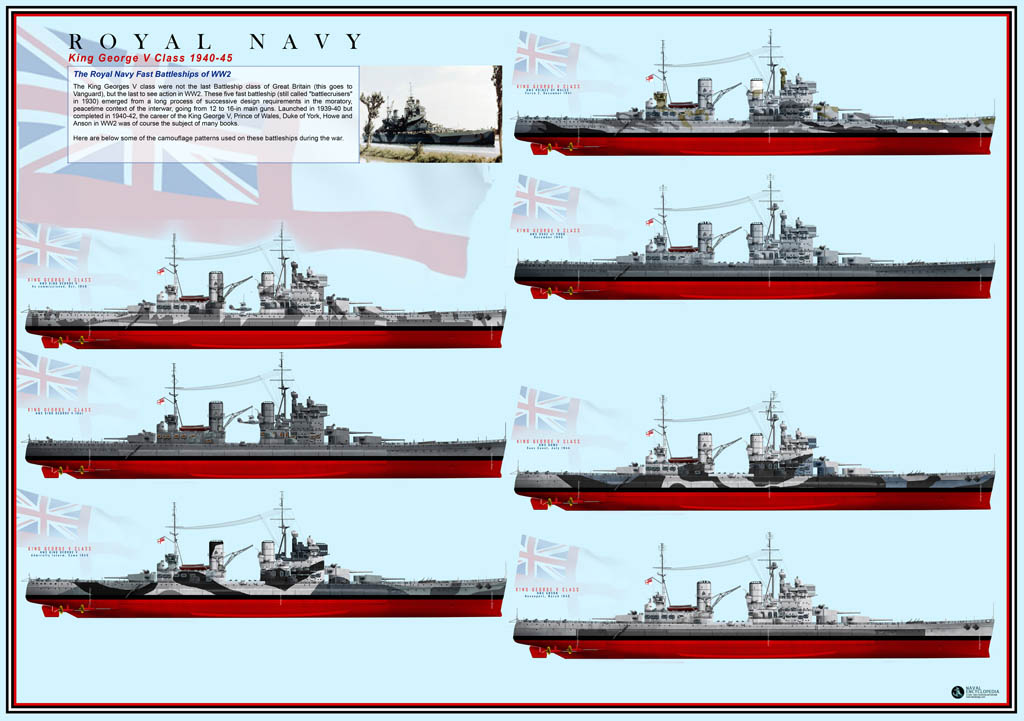
Help support the site – King George V class poster
Design development
Post Nelson designs
Genesis of this class way before 1936. The very early, initial design process started in 1928: Under Washington Naval Treaty’s 1922 “holiday” in force through to 1931 and with only left ten ‘super-dreadnoughts’, the QE and Revenge classes and the “special authorization”, slow Nelson-class battleships. So requirements for future warships needed in 1931 were laid down.
In 1929 there were considered 16-in guns designs with twin turrets, split secondary batteries but still slow ships with internal belt armor, very much a continuation of the Nelson class, but more conventional in their approach. The twin turrets were indeed generally eight, and heavenly placed fore and aft, unlike the Nelson class which tried a concentration of armour ot save weight. Indeed, it was planned that with the planned expiration of the Washington treaty in 1932, 36-38,000 tonnes designs would be approved, rather than the 35,000 tonnes after a renegociation.
The First London Naval Treaty of 1930 extended however this “shipbuilding holiday” to 1937 and more serious planning was done in 1935 based on the maximum 35,000 tons authorized, with alternatives having 16, 15-inch and 14-in main guns until the admirakty stuck on a 15-in main armament, based on 27 knots and a protection molded on the new assumptiopn decisive range was to be 12,000 to 16,000 yards. There was also an end to the “all of nothing” scheme, with a better, extended protection for fear of shattering effects of gunnery on unprotected parts of the ships. Below is the whole process.
1933 Staff Requirements
1933 specifications focused in speed and size, and again, up to 38,000 tonners were envisioned as per expected treaty renegociations. Considerations about speed looked as the Dunkerque and Scharnhorst, and examined guns, with a plethora of potential designs, still all relatively more conversative than the Nelsons, very much oddball prototypes. This led to a final 1933 set of requirements intended for a FY1937 capital ship (laid down in 1936).
It was planned that it would have:
-Four twin turrets in the classic QE/Revenge configuration (likely 16-in caliber)
-Twelve 6-in guns (152 mm) in battery mounting, not casemated.
-Extended AA of six guns either side, ideally 4 or 4.7 in, four PomPom and Vickers four 0.5 in HMGs
-Torpedo tubes above water, in quintuple mountings
-Protection hypothesis A (still 32K tons): Proof against 16 in shells/2000 Ibs bomb/1000 Ibs for terminal velocity
-Protection hypothesis A (Below 32K tons): Protection against 14 in shells but still 2000 Ibs bombs.
-Underwater protection: Proof against 1000 Ibs contact warhead
-Speed: 23 knots minimum
The admiralty transmitted this to the director of naval construction (CNT) which came back with a ship above 32,000 tonnes.
1930s Arms Geneva control Revisions
Yet, all this prove too optimistic. A meeting held by the 1st sea Lord on January, 10, 1934 was about discussing size in expecation of the 1935 naval conference. Switzerland proposed to limit tonnage to a mere 25,000/22,000 tonnes with 12 and 11 in respectively. Japan though (as usual) it could pull up a battleship capped at 25K tons and yet proposed 14-in guns. For the sake of standardization, the US argued nothing less or more than 35K would do for them. Another gunnery revision came from the 13.5 in guns of the Frennch Dunkerque, based on 23,000 tonnes, which saw the 12-in jumping to 13-in.
The Germans also looked at a 25,000 tonnes design to replacer the Deutschland in reply to the French.
Admiral Bellair reported from Geneval he might obtain ffrom the US a capping to 28,000 tonnes and 12-in guns. And so the staff pressed the DNC to look at designs with between eight and ten 12-in guns with 23 kts, still considerable protection, better AA on a 28K displacement.
The 1934 12-in guns designs
Successively: Lenght (ft oa) x beam; shp; top speed; 12-in configuration; 6-in numbers; 4.7-in numbers; 0.5-in HMG numbers, TTs, belt armor mag/mach.; Deck armor mag/mach; standard displacement:
12N: 614 x 102 ft; 45K shp, 23kts; 4×2; 12; 4; 8; 2×5 TTs; 12.5/11.5; 5.5/3.5-in; 28,500 tons
12O: 614 x 102 ft; 45K shp, 23kts; 3×3; 12; 4; 8; 2×5 TTs; 12.5/11.5; 5.5/3.5-in; 28,130 tons
12P: 634 x 103.6 ft; 45K shp, 23.25kts; 2×2+2×3; 12; 4; 8; none; 12/11; 5/3-in; 28,500 tons
12Q: 634 x 103.6 ft; 45K shp, 23.25 kts; 4×3; 24; 4; 8; none; 12/11; 5/3-in; 28,500 tons
12R: 634 x 103.6 ft; 45K shp, 23 kts; 3×3; none; 24; 4; 8; 4×3 TT; 12.25/11.25; 5.5/3.5-in; 28,500 tons
12S: 634 x 103.6 ft; 45K shp, 23 kts; 3×3; none; 24; 4; 8; 4×3 TT; 12.25/11.25; 5.5/3.5-in; 28,500 tons
12T: 634 x 103.6 ft; 45K shp, 23 kts; 4×2; none; 24; 4; 8; 4×3 TT; 12.25/11.25; 5.5/3.5-in; 28,500 tons
It should be noted that all carried at least one aircraft, apart P and Q, the last three even having four. The 12R had 24 4.7 in dual purpose, but space was limited to have all these installed with an acceptable arc of fire, in addition to a lot of exposed crews, and this was objected by the naval staff. The triple mounts on either sides were surprising, as much as they belonged for cruisers, and combination with a hangar and transverse catapult complicated things even more.
The 1934 14-in guns design
The Americans objected and wanted to stick still with their standard, or as close at it as possible, and the British Naval staff proposed two variants for their acceptation, that can fit the bill also for the RN. Due to the gunnery upgrade on the same displacement, serious sacrifices were made. This was expressed on 10 October 1934, as primimany staff requirements:
Design A: 4×3 main, 24 sec. DP, same AA, still 3 TTs, 4 aircraft*, 14-in protection at 15K yds/90°, bomb at 10K ft, against plunging fire 28K Yds.
Design B: 3×3 main, 20 sec., same AA, no TTs, 2 aicraft and no hangar, same protection.
*It was precised two fighters and two recce/observation/spotting “TSR” models (the Swordfish).
This in turn generated via the DNC a set of five new designs called 14 TLA, TLB, TLA(x), TKA(y), 14Q.
14 TLA: 660 x 106ft, 46K shp, 23 Kts, 4×3, 24, 4+6 AA, 4TTs, 4 Air. on 34,000 tons
14 TLB: 600 x 105ft, 45K shp, 23 Kts, 3×3, 20, 4+6 AA, none, 2 Air. on 30,000 tons
14 TLA(x): 630 x 106ft, 35K shp, 21 Kts, 4×3, 24, 4+6 AA, none, 4 Air. on 32,500 tons
14 TKA(y): 650 x 106ft, 46K shp, 23 Kts, 4×3, 24, 4+6 AA, none, 4 Air. on 32,500 tons
14Q: 660 x 106ft, 45K shp, 23 Kts, 3×4, 24, 4+6 AA, 2×3 TTs, 4 Air. on 32,800 tons
The armour scheme for all included a 13-in thick main belt, 12.25 in over the machinery, 5 in over the magazine, 3.5 over the machinery (both vertical) for the all designs but 12.5-in, 11-in, 5 and 3-in for TLA(y).
The interesting point was the realization quadruple turrets could be a solution, with design 14Q. With three quad instead of triple turrets, the reduction of the armor was possible on a slightly heavier displacement, authorizing to beef up armor from 11 inches to 12.25 inches for the belt armor over machinery and 3.5 inches for its vertical protection as well.
1935 design studies and considerations
In the admiralty 113/4041 documentation, several points were observed. First the main armament weight in various configurations. By far the heaviest was the Nelson configuration in three triple 16 in (406 mm) with around 7,160 tonnes, compared to the lightest, 3×3 14-in (5,550) and the quad 14-in (356 mm) turret solutions comparing well at 6,750 tonnes to the three triple 15-in (381 mm), with the guns and turrets, but not the barbettes and wells.
It was considering the shattering effect of lower caliber guns on unprotected areas or the machinery was quite valuable, combined with a greater reload speed.
The factor of speed mattered little in the grand strategy, between the positions of bases and reconnaissance. It was estimated on this base that 27 knots was the most acceptable, rather than 30 kts.
The “decisive range school” went to argue that the greater punch and range of modern guns made all the more necessary to bolster armour thickness whent possible (a realization like for the US of long range gunnery primacy in future tactics). It was pitted against proponents of the “gun power school”, which wanted to devote more weight to larger guns, and less on armor or only on most critical areas. They saw Jutand reports about oblique fire being paramount on the QE class and they did better for protection in action than on the testing ground, which is under very controlled conditions unlike combat. This was very much the old Fisher credo of “hit them first”.
However soon the admiralty agreed than for any efficience, warships (especially in the north sea where visibility was poor, between absence of spotter aviation, fog, and smoke), 50,000 yards was rather the optimal distance for primary engagement. So gunnery range mattered less. Another argument was to solve the “decisive battle” the RN wanted to “force the decision” and for this go to contact instead of skirmishing at a distance. In 1934, neither ballistic computers or fire control systems had changed much since 1918. A completely different approach would have been needed in the Mediterranean.
five new designs called 14, 15 and 16 according to their main caliber (in inches). Dimensions were understood as 650-660 ft overall, 106 wide, on 35,000 tonnes (The anglo-German naval treaty was discussed in 1935). Speed follows here the caliber, and armor (belt, barbette, deck mag/mach.).
14C: 3×4; 30 kts; 11.5, 12 x 5/3.5 in
16A: 3×3; 30 kts; 11.5, 12 x 5/3.5 in
14E: 2×4 + 1×2; 30 kts; 12.5, 12 x 5.25/5.25 in
15A: 3×3, 30 kts, 12.5, 12 x 5.25/4.25 in
14F: 3×4; 27 kts; 12.5, 12 x 5.5/5 in
16C: 3×3; 27 kts; 11.5, 12 x 5.25/5.75 in
14D: 1×4 + 2×2; 30 kts; 13.5, 12 x 6.25/5.75 in
15B: 3×3; 27 kts; 13.5, 12 x 6/5.25 in
16B: 2×3 + 1×2; 27 kts; 13.5, 12 x 6/5.25 in
14J: 3×4; 28 kts; 13, 12 x 6/4.5 in
14K: 3×4; 29 kts; 12.5, 12 x 6/3.75 in
15C: 3×3; 29.5 kts; 14, 12 x 6.25/5 in
The 16C seemed favorites but still weak, armor wise.
In the end, it was decided that for a 30 kts ship, the 15-in variant was equal to the 16-in armour wise due to better protection, that the 27 kts ship the 15-in variant is again preferrable, even to stand against a 16-in ship. As for the 23 knots type, it seems hitting (and thus rate of fire) was again the most important factor, even though the overall armor was superior. In that case, the 16-in should have the advantage. It was also expected aviation would have a greater role and again, the protection of the 15-in ship variant seemed better placed. In the end also the 14-in and 15-in were about the same for “hit factor” anyway, statistically, better chances of a critical hit than a 16-in, depite the latter much greater hitting power.
By late 1935 it was decided to go for Nine 15-in guns, 29 knots, but three weeks later, twelve 14-in guns and 30 knots.
Consequences of the 1936 London Naval Treaty
Reduction hopes were shattered when Italy left treaties and decided to built two 35,000 tons capital ships with 15-in guns, the Littorio class. Immediately France and Germany jumped on the same bangwagon and Geneva’s distant hopes of limitations were definitively buried. Due to this on 20 September 1935, Sea Lords set their choice of nine 15-in guns and 29 kts to match. But soon it was realized that “battlecruisers” (in British parlance, in reality these were fast batteships past 28 kts) with 15-in guns would be needed to face Japan’s 16-in armed Nagato class, and it was discussed how to set instead a standard of 15-in whatever the type for all theaters.
It was also assumed that Japan would go for smaller calibers to answer initial US researches for the North Carolinas and their dreadnought standard, which never happened. At 35,000 tonnes a 16-in armed fast battleship would have to make armor concessions as shown by 16A, B, C.
Among other decisions following this and the apparent choice of three quad 14-in guns turrets, was to raise the armored deck of one level.
In October 1935, decision was made to use 14-inch guns while negotiating for a continuation of the Naval Treaties, the Government still favouring, hoping for a reduction in maximum caliber to 14 but ultimately learning that that the United States would only support them if the were persuaded to follow -which was a vain hope given the militaristic, ultranationalistic nature of the regime by then).
An artillery choice based on emergency
The admiralty could not wait answers from the Japanese authorities, which in turn prevented any position of the US, and since the large naval guns needed to be ordered by the end of the year to be ready for installation anyway (a new gun model was needed, requiring at least three years of development), the British Admiralty decided on 14-inch guns for the upcoming King George V class. The Second London Naval Treaty, signed at the end of the Second London Naval Conference (December 1935-March 1936) was signed by the US, France and Britain only (Japan and Italy retired, Germany and USSR were out anyway), and together indeed, set a main battery with 14-inch naval guns as limit. But it was nothing more than a waterbubble:
As soon as the Littorio class was announced by Mussolini indeed, France decided for a new design (The Richelieu) with same 15-in (381 mm) caliber guns, as did the Germans (Bismarck), while the US, to answer IJN battleships with 16-in guns and fearing a new design using the same or more, decided to stick with 16-in for the Washington class.
Meanwhile, Britain was stuck with a 35,000 tonnes, 27 kts battleship armed in theory with quadruple turrets with the newly developed 14-in guns…
The choice of 14P and primacy of armour
The raisoning of the armored deck raised to the middle deck generated three more designs: 14N, 14O and 14P, the latter being the final one chosen. All three differed in many aspects.
14N: 12×14-in, 20×4.5-in, 4×4 pompom, 4×4 Vickers HMG, 100,000 shp, 14-in lower belt mag., 13-in lower belt mach., 6 and 5 in decks, middle armor deck level, on 35K tons.
14O: same, 16×2.25-in, same, 110,000 shp, 13-in upper, 14-in lower belt mag., 12-in upper, 13-in lower belt mach., 5.5 and 4.5-in decks, Main armor deck level, on 35,450 tons.
14P: 10×14-in, 16×2.25-in, same, 110,000 shp, 15-in upper, 15-in lower belt mag., 14-in upper, 14-in lower belt mach., 6 and 5-in decks, Main armor deck level, on 35,500 tons.
So 14P presented a much better armor for the sacrifice of a quad turret, swapped for a twin one, and slight tonnage increase. This was chosen for the King George V class as laid down.
This increase of armor was supposed to allow the ship to operate when and where required, even under strong attack, security against shell fire until decisive range of below 16,000 yds was reached,
and still the rate of fire and firepower scale needed to deal with foreign 15-in designs, primacy of European waters as main threaters of operations with focus of greater chances of air attacks and thus, great confidence given into the new 5.25-in caliber in development (we know how it ended).
Thus by that stage in 1936, requirements of armour became paramount. The delay of completion was pushed back realistically to spring 1940 at this point, which was less vital if peacetime was maintained, which became a prime objective for both French and British Gvts. at that point or rising tensions (the appeasement policy). There were concerns about the completion of the Bismarck class, and it was estimated it would take until late 1942 for the Kriegsmarine to have five potent battleships. In addition still, global strategy mattered more than ship-to-ship comparisons. Having the best design (protection wise) however mattered more than delays at this point for the admiralty. Indeed, it was always possible in the future to improve main gunnery, AA strenght, improve fire control and detection, but not armour which was “fixed” for decades (apart perhaps additional blisters or easy add-on plating when possible).
In the end, the irony of all this was no nation was ready after the end of the treaties’s vacancy was ready when WW2 broke out. Neither the Royal Navy, caught pants down why building the KGV class, or the Germans with the Bismarck class, the French with the Richelieu class, the US with the North Carolinas class and so on.
It is also interesting to note that the North Carolinas were -as per the London treaty in 1936- at first were designed with three quadruple turrets with 14-in guns, exactly like the KGV. But they diverged in armor with their external belt one deck below, overall they looked very similar, but of course a last minute change swapped to triple 16-in, while the rest same about the rest. The British still had the possibility of a “swap” later, but they new they would need a larger ship, which would become the Lion class. But on the KGV it would need to make sacrifices. There was just less time as compared to the North Carolinas. No more delays was the order of the day.
Construction
Construction of the first two KGV class battleships was voted and the first two ships authorized and ordered on 29 July 1936.
HMS King George V was assigned to basin N°10 in Vickers-Armstrong Yard, on the Tyne. She was laid down on a symbolic first january 1937, launched on 21.2.1939 and completed on 11.12.1940 at a cost of £7,393,134. It would be the equivalent of £489,127,794.22 today, adjusted for inflation. src
HMS Prince of Wales was assigned to Cammell Laird, Birkenhead, laid down at the same time of her sister ship, on 1.1.1937 but launched later on 3.5.1939 and completed almost four months later on 31.3.1941, having an intense, but short career and only one sunk.
HMS Duke of York was the ex-Anson, renamed after being ordered, to John Brown, Clydebank a bit later compared to the others, laid down on 5.5.1937. She was launched on 28.2.1940 but still completed on 4.11.1941, having a less intense, but still valued career compared to the others, completed with a battle victory.
HMS Anson (ex-Jellicoe) ordered to Swan Hunter, Wallsend and laid down on 20.7.1937 was almost suspended when WW2 borke out. Work resumed until her launch on 24.2.1940 but she took more than two years before completion on 22.6.1942.
As for HMS Howe (ex-Beatty) she was laid down at Fairfield, Govan on 1.6.1937, same batch as her sister Anson but launched later on 9.4.1940 and completed just two months later at 29.8.1942.
The general public retains the name of the first three but generally forgets about the last two. Their late completion meant most bet assets of the German surface fleet were no longer a threat apart the confined Tirpitz, the Kriegsmarine swapping on U-Boat warfare at this point. Their career was certainly less appealing than the others.
Design of the King George V class Battleships
Powerplant
The compartmentalisation of their engine room saw boilers and machines grouped in pairs to prevent a single shot paralyzing all propulsion. Nominal output was 110,000 horsepower at 230 rpm. Steam was injected into the tubes at 371-5°C.
Specs in short:
-Four steam turbine rooms, four boiler rooms, eight machinery compartments total alternating in pairs.
-Each pair of boiler rooms was paired with engine rooms.
-Nominal output: 110,000 shaft horsepower (82,000 kW)
-Working pressure: 400 Ib /sq. inch (28 kg/cm2; 2,800 kPa) exiting at 700 °F (371 °C).
-It was also designed to operate with overload or “boost” mode up to 125,000 shp (93,000 kW)
-HMS Prince of Wales main machinery could even reach 128,000-134,000 shp and showed this during the hunt for Bismarck.
Boilers Issues
The eight Admiralty 3-drum boilers paired for each turbine operated very efficiently. They inherited a long-standing and very efficient design from the interwar, that, when fitted to older dreadnoughts, such as the rebuilt HMS battleship Warspite during her 1937 reconstruction showed a 0.748 lb per shp on trials.
Sea trials for the lead ship King George V on 10 December 1940 showed an output of 111,700 shp at 230 rpm based on a 41,630 long tons displacement. Specific fuel consumption was 0.715 lb per shp.
The problem emerged after 1942, when the Royal Navy was forced to use fuel oils due to shortages, with considerably higher viscosity and greater seawater content. Poor quality, plus seawater contamination drastically reduced the boilers efficiency and complicated maintenance; Indeed by 1944 the efficiency was now up to 0.8 lb per shp. The Admiralty in between urged the adoption of new types of oil sprayers and burners to regain some efficiently, which were installed on HMS Duke of York and Anson, managuing to regain this full efficiency. The same installation was used on HMS Vanguard, which in fact having in addition the benefit of peacetime, better quality fuel oil reach an eficiency as far as 0.63 lb per shp based on the very same steam pressures and temperatures.
Armor protection
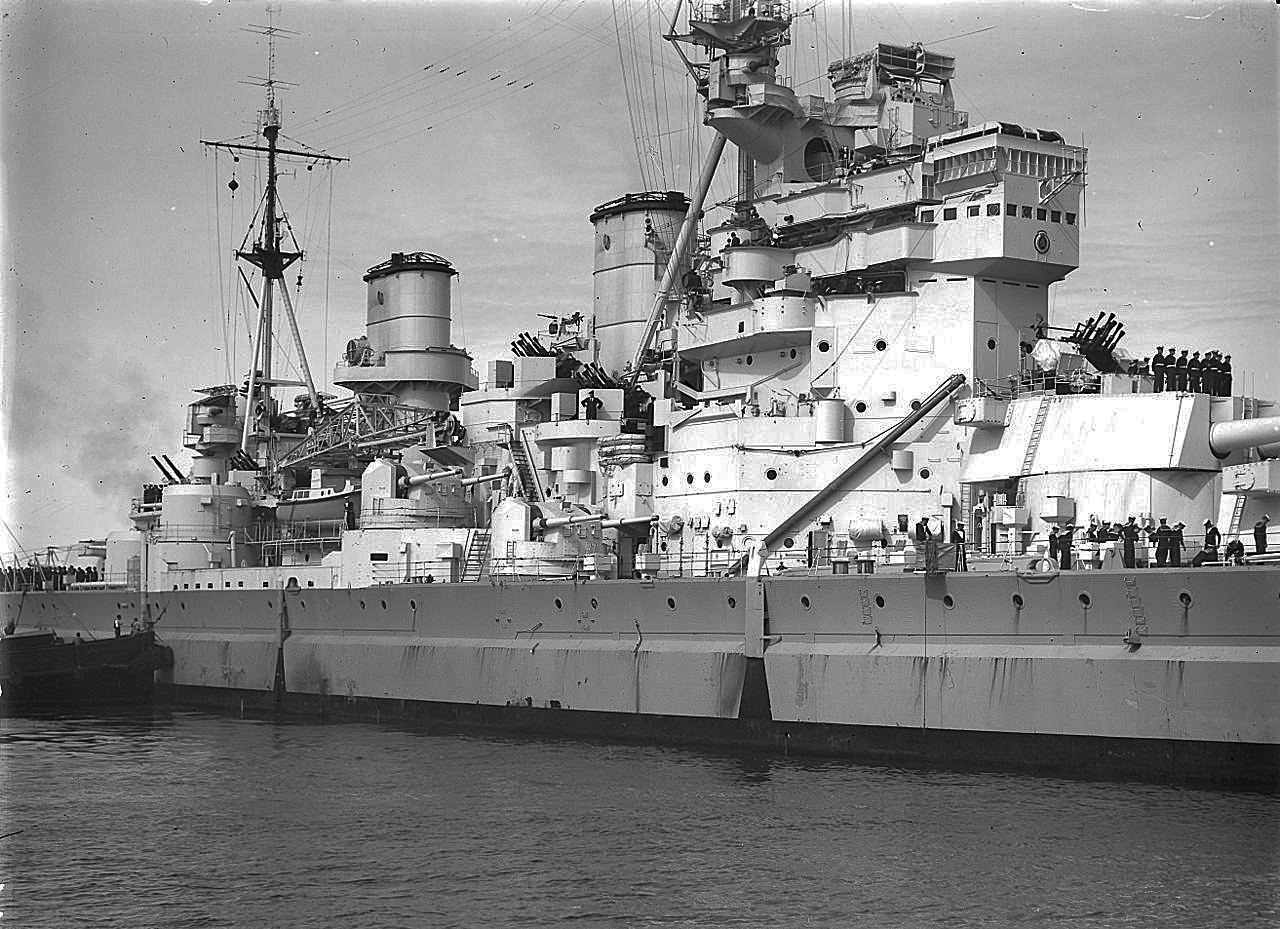
HD protection Details of the King George V, midship section
The armor protection compared to the Nelson class had made a long “trip” and was revised and expanded to less vital parts of the ship, no longer applying as said above the “all or nothing” scheme.
In 1934-36 were studied options, notably comparing the sloped armour and sandwich bulge options, and vertical armor advantages and same bulge. ASW protection main principles were accepted quickly and included, on a 106 to 102 feet beam, the same structure underwater, with an air void, followed by a water jacket, and then another air space, but in the first case, the main 13-in armour was sloped downwards to deflect incoming high angle shells, and internal walls followed the same angles slope the armour being internal with a 10-8-6 in thick external hull from above the waterline.
The vertical armor scheme had the main extrernal flat armor, 14-in thick, resting on the same sandwich, but the armor deck was flat above both the air void and water jacket, and then sloped on about a full deck height until meeting the bottom of the main belt in a sloping manner. Even in that case, the main armor was a sandwich of 10 and 9.6-in above and below the waterline, backed by the main 14-in plate. The main point about these designs compared to the Nelsons was that modern shells, as shown in several tests, can dive underwater, and thus bypass old style “high-up” vertical armor schemes. Underwater armor had to be cared for. This orientation was done as early as October 1933.
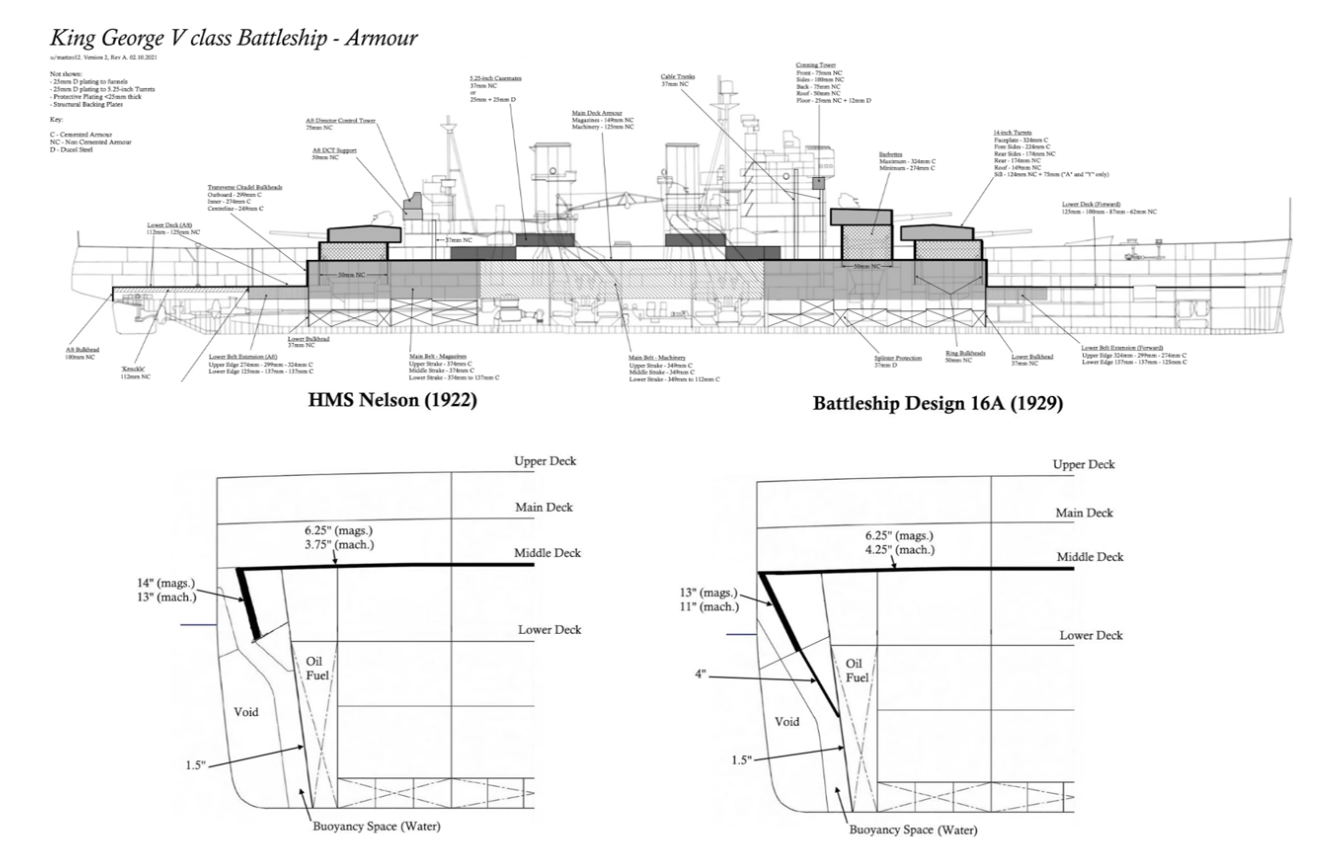
General armor scheme src
The greatest changes in armour layout from 1933, Option B (vertical armor) was of course the raising of the armored deck to the main deck, its key feature, instead of the middle deck.
Note:
-The upper deck was the weather deck
-The Main deck was the first internal deck below
-The middle deck was a utilitarian level below, both traversed by barbettes
-The lower deck was the last deck above the machinery.
Thus, the “raft” created by the citadel moved one step above with a downards sloped 1-in upper deck hull side, followed by a 15-14-in main belt armor, external, tapered down to 5.5-4.5-in below the waterline. The main armor deck (at main deck level) was inbcreased to 5-6-in and the internal ASW sandwich was lower, starting below the waterline level. The middle water jacket was now filled with oil optionally and there was no longer a second oil filled internal compartment next to the machinery longitudinal bulkhead. The larger volume in the citadel created by this choice in turn added more buoyancy in case of flooding. Indeed, in case the ship was flooded badly, the hope was the main armour deck to stay as much as possible well above the waterline still, especially in case of aerial bomb blast. It was estimated in 1936 that any new SAP bomb would have a greater distance to travel before hitting any vitals.
In all previous designs, armour figured revolved around two main armour schemes:
-Belt armour (vertical protection) over the machinery and ammunition magazines, which both were the most vital parts of the ships
-Deck armour (Horizontal protection) over the same locations. For the latter especially, every inch or even half-inch increase due to the much larger area to cover meant hundreds of additional tons.
-The protection of machines benefited most attention, since if the ship lost power, it lost also all ways to control the artillery and FCS in addition of being a sitting duck. The belt was widened downwards, while internal subdivision and central armored caissons were lengthened considerably. Nevertheless, deck protection against aerial bombs remained largely sufficient due to weight sacrifices to stay withing the 35,000 tonnes limit.
The turret armor was lowered in thickness a bit, less the barbettes and wells, whereas ammunition bunkers benefited on the contrary the greater increase, while being better distributed. To achive acceptable stability, the rather large superstrcuture, a development of the Warspite/QE/Revenge “queen ann’s mansion” design was considerably lightened despite the bulky appareance, and the roof protection only reached 100 mm. In practice, officers always favored overall visibility to the protected containment of the conning tower.
Horizontal Protection:
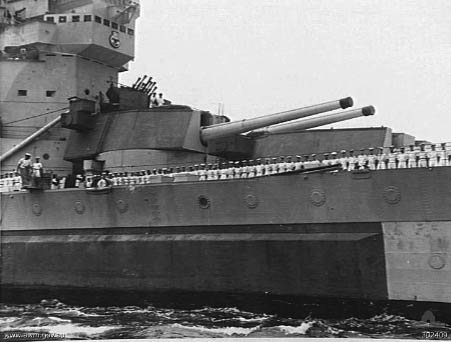
Details of the armored belt, near HMS Howe B Turret, Sydney 1944
Postwar studies showed that the new delayed-action AP shells could in fact dive under a shallow belt and thus penetrate vital areas. Engineers were asked to majke the main belt as deep as poissible below the waterline as a result. The belt started forward of the N°1 turret and ended aft of N°3 turret, a very common scheme but composed of three equal-depth strakes, tongue-and-grooved together. Each individual plate was keyed into neighbouring plates for added strenght. Of course all was made in high tensile steel to the best standard. This was essentially for the strongest part (close to the magazines) made in cemented armour, laminated onto 1 in “composition material” stuck to a surface of 0.875 inch (22.2 mm) Ducol steel hull plating. British cemented armour which provided excellent resistance and reinforced the admiralty into believing the relatively low thickness was deceptive.
-Main armour belt 23.5 feet (7.2 m) high, from main armoured deck to 15 feet (4.6 m) below waterline.
-Main armour belt, waterline 14-15 inches
-Main belt along the magazines 14.7 inches thick (373 mm)
-Main belt along the machinery spaces 13.7 inches (349 mm).
-Belt, Lower section 4.5-5.5 in.
-Armoured citadel forward armoured bulkhead: 12 in (305 mm) thick
-Armoured citadel aft armoured bulkhead: 10 in (254 mm) thick
-Main armoured belt past bulkheads 13-5.5 inches.
Immune zone calculations was setuop to resist greater caliber, about 15 and 16-in shells, and only exceeded by the Yamato-class. It was in fact far better than the main caliber could have suggested. The KGV were nowhere near as “weak” as sometimes portrayed given the armour thickness reading alone.
Vertical Protection:
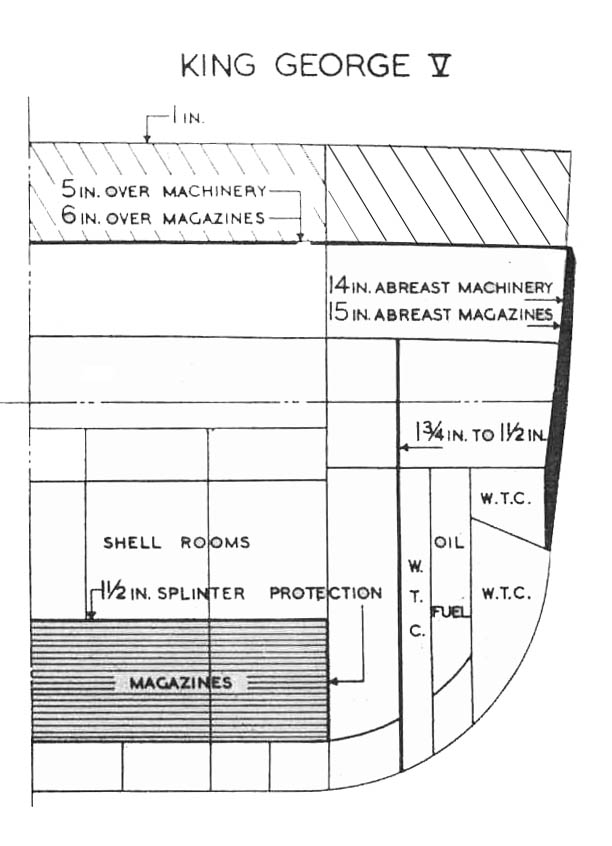
KG V Armor scheme
It was three layered for a combined 9.13 in (232 mm):
-Weather deck 1.25 inches thick with Ducol (D) steel
-Main armoured deck below (one deck higher as decided in 1935) 5.88 in (149 mm) in non-cemented steel + 0.5-inch D steel deck
-Ammunition magazines had a 1.5-inch splinter deck
-Powder magazines were below the shell rooms (borrowed to the Nelson-class battleships design)
-Machinery spaces had the main armoured deck 4.88 in (124 mm) + 0.5-inch D steel deck
-Main armoured deck, forward of the main armoured bulkhead: to 2.5 inches
-Main armored deck past the after magazines: 4.5–5 inches turtleback also covering the waterline.
Main Turrets protection:
-Main gun turrets 12.75 inches (16 in for the Nelson class) for the frontal arc.
-Turret faces 12.75 in (324 mm)
-Turret sides 8.84 inches (225 mm) and gun chamber
-Rea sides and back plate: 6.86 inches (284–174 mm)
-Roof plating 5.88 in (149 mm) thick.
-Main barbettes 12.75 in (324 mm) over weather deck
-Reduction one deck deep to 11.76 in (298 mm) forward, 10.82 in (275 mm) aft.
Notes:
> The higher quality of the armour minimized this protection reduction.
> Design-wise the sloped face improved ballistic resistance at long ranges, and low profile at closer ranges.
> Reduction in turret and barbette armour was returned in favor to increased magazine protection
> Extensive anti-flash protection in the turrets and barbettes designed to prevent any communication to the magazines.
Secondary Turrets protection and Conning Tower
Secondary gun mounts, with their turrets, casements and handling rooms were only protected by 0.98 in (25 mm), just sufficient against splinters.
Unlike other battleships of their time (The US would reach the conclusion they coukd get rid of CTs altogether later) the King George V class had a light conning tower, with walls just 4-inch (102 mm) facing forward, unequal thickness of 3 in (75 mm) on the sides and aft and topped by a 1.47 in (38 mm) roof. Analysis of WWI actions indeed pointed out command personnel preferred superior visibility. So the CT became an “imrobable backup”, some kind of insurancy born from naval combat forms where distance was shorter and accuracy poorer. This in addition solved Stability and weight issues. It was only valued for its protection against moderately large shell fragments.
Underwater protection
Development
The design development of the unerwater protection is also an interesting topic, especially because ot was all-internal, but still narrower than contemporary designs, especially compared for example to the Litorrio class Pugliese system, or the one chosen on the Yamato class. All in al, engineers managed, thanks to the new, higher main protective deck, to create a more compact three-layered system over just 14 feets (4.26 m) but it benefited from live tests in full scale, proving itself. Torpedo bulkhead ranged from 1.5 to 1.75 inches (38 – 40 mm).
Further internally the machinery was divided into eight modules in roughly the center of the ship, with the two B and A outer engine rooms further apart and separated by two harbour machinery rooms, thus closer to the bulkheads, a potential weak point. X and Y machinery spaces were actually further aft than their own boiler rooms, all inline unlike A-B ones. The rest of the “central trench” protected on both sides, fore and aft of the machinery, itself surrounded by auxiliary machinery rooms and diesels, were located the ammo magazines eight aft for the Y turret (plus a ninth in front of the barbette) and 5.25 in aft turrets, and forward, four 5.25 in mags., and four main ammo mags. installed alongside the A and B barbettes. There was also a double bottom 4 feet deep running all along the ship, but after the underwater sandwich, below the machinery spaces.
Below the waterline, engineers devised the side protection system (SPS):
The principle was a Subdivivision into a series of longitudinal compartments with the void middle ones filled by liquid (like additional oil), outer and inner compartments filled with air.
-The Outer hull plating was thin, to just stop torpedo initial splinter damage.
-Outer void or air filled compartment allowed the initial explosion to expand, 13 feet wide.
-Middle compartment filled with oil/seawater spread the pressure pulse and contained splinters.
-Inboard compartment contain liquid leaking and remaining pressure.
See also
The main armoured bulkhead behind this STS ranged from 1.5 in (37 mm) (machinery spaces) to 1.75 inch (44 mm) (magazines). This bulkhead was designed to resist residual blast pressure. If penetrated, subdivided compartments behind would contain any leaks. Further inwards, relatively small compartments contained the auxiliary machinery spaces with around 8 feet more of space until reaching the major machinery spaces own walls. A and B Engine Rooms however missed the auxiliary machinery spaces, replaced by a narrowed void space.
Above all this, and in contact with the lower armour belt, new compartments used for washrooms or storage favored upward venting of overpressure.
All this was tailored to damp and resist a 1000 lb warhead effect. This sandwich was built into a whole section and tested while plunged in water. It was found effective and validated. Any lists from flooding in addition could be compensated by easy counterflooding in opposite empty void spaces or just pumping out liquid filled compartments, if the pumps were workable and not disabled.
Protection case: HMS Prince of Wales
The only battleship of this class, and one of the rare British battleships which was sunk in WW2 (With HMS Royal Oak and Barham) is an intersting case that fuelled debates after the war, between historians and not the admiralty as the cold war condemned the battleship as a viable type. HMS Prince of Wales was indeed sunk on 10 December 1941, from -as believed- six Japanese aerial torpedoes, and a 500 kg bomb.
The extensive 2007 survey by divers on her wreck helped to solve large parts of the mystery. They determined four torpedo hits, not six, and that three of these struck the hull outside the area protected by the SPS. The fourth one hit the SPS holding bulkhead, which looked intact abreast close to the hit. As shown in a 2009 report, primary cause was something engineers would have perhaps not expected: Uncontained flooding along “B” propeller shaft had its external shaft bracket failing, sending the rapidly spinning, enormous shaft tearing up the bulkheads. And this was all the way from the external shaft gland, up to B Engine Room, which was flooded, condemning the primary machinery spaces.
This was aggravated by apparently poor damage control with premature abandonment of the after magazines and telephone communications switchboard which would have allowed last minute measures. “B” propeller shaft stopped was nevertheless restarted, causing much damage without knowledge of the true extent of it. At the time in early 1942, several design improvements were recommended to the other four battleship, such as a better watertight ventilation system, redesigned internal passageways (in machinery spaces) and a more resilient internal communications system.
It was decided to improve propeller shaft glands and a locking gear to avoid a loosening shaft to cause damage.
Supposed failures were predicated by engineers though if the hit was done on frame 206 on B propeller shaft. The 2007 survey was however fustrated by several reasons and incomplete, fuelling more theories afterwards.
It was also nor predicted in the damage report after POW’s encounter with Bismarck and Prinz Eugen. Three hits caused a flooding by 400 tons of water, and one crucially, penetrated the torpedo protection outer bulkhead close to the auxiliary machinery space. The inner D-steel holding bulkhead remained intact since, crucially, this shell was a dud. Although inconclusive, the majority believed the STS was a safe system which would play its role in nearly any scenario.
The main question is: Did the PoW suffered important shortcomings in her underwater or armor deck protection causing her demise when attacked by IJN aviation on 10 December 1941 ?
Above the question of “passive” protection of course everyone had its own opinion on the “active” protection layer, of course the AA, which in her case was not “upgraded” with scores of 20 and 40 mm US pattern guns. Still “in her juice” when sent to Force H she carried her original sixteen 5.25 in secondary turrets and Pompoms. Captain Leach was not to blame for his dodging skills, neither the crews and she put a fierce AA defence that day despite an overwhelming opposition. Even when the last bomber squadron (Takeda Sqn.) arrived for the coup de grace, when the battleships was reduced to 6 knot and sinking, PoW still hit five out of his eight bombers.
As for the supposed “rubbish” ASW defence, it took four near-simultaneous torpedo hits on the first wave to damage her seriously on the first pass, plus a bomb hit. The torpedo bulkhead held the first three, but one lucky hit struck close to the outer shaft, which in turn created the most initial damage. This was the sole source of flooding and almost totally unexpected, to put on the same level as the very unlikely hit that exploded the Hood. Counterflooding was used also and the scale of the attack was in any case beyond what the ship was designed to sustain. The biggest issue were repeated attacks that prevented damage control after this first one and the fact that hald her power was gone (along with electrical wiring) early on, negating the use of AA and FCS early on in this engagement. She therefore never had the chance to show what she could do. In fact few designs could have survived that amount of punishment, but perhaps Yamato and Musashi, but they were of another scale entirely.
Armament
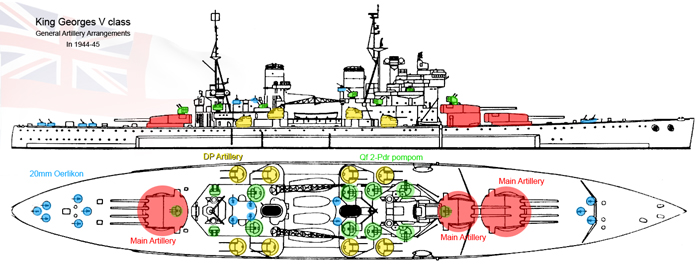
The main armament, initially of three triple turrets and 15-in guns was down to 14-in (356 mm) due political pressures after the London Treaty forced and the use of quadruple turrets instead of triples only possible with such caliber, enabled more guns to bear, a total of twelve guns instead of nine, and of a new moderl, hopefully with longer range and better accuracy but, most importantly, greater rate of fire. A completely different philosophy compared to the WWI 15-in guns (381 mm), born from the assumption range would be lower and fire volume mattered more than hitting power.
The admiralty realized with horror the direction taken by other navies in 1936 but the adaptation of 16-in guns would trigger such delays they would have jeopardize the entry into active service the lead ship, perhaps (according to modern calculations) as far as early 1941. The quadruple turrets were an entirely new design and a risky proposition which translated into many teething problems at the start of the war. The events of May 1941 showed this in particular, combind with “light shells” proved almost fatal to the POW.
As completed, the lead ship, King George V had two 14-in or 356mm/45 BL Mk VII in turrets Mark III and a single twin 356mm/45 BL Mk VII in turret Mark II, eight twin 133mm/50 QF Mk I DP guns, four Octuple 40mm/39 2pdr QF Mk VIII Pompom (later extended to eight), and four 20-tubes 178mm UP rockets projectors. There was none of the planned Vickers 0.5 in quad HMGs, and they were not installed later. AA reinforcement came in 1941 onwards.
Main BL 14-inch/45 Mk VII naval gun Battery
Genesis of the 14-in guns
When the caliber was solidified in 1936, design started right away and officially on its way in early 1937, and were the first 14 inch (35.6 cm) guns exclusively designed and accepted into service by the Royal Navy, the previous ones indeed of earlier Marks being manufactured “as private ventures” for foreign-ordered battleships, requisitioned when WWI broke out. So this new generation started almost with the blank page.
High-velocity heavy gun had been cast aside after many issues encountered with the 16″/45 (40.6 cm) Mark I (Nelson class) and the new Mark VII was a lower velocity gun, closer to the 14″/45 (35.6 cm) Mark I from HMS Canada/Latorre. It was based on the generally considered excellent but experimental 12″/50 (30.5 cm) Mark XIV completed in August 1933 testing “all steel” construction techniques and thus, the body used no wire but rather a radial-expansion construction. This made for no extra material and a strongeryet lighter gun, which was in the end more accurate and with a much greater barrel life than the Nelson’s 16″/45. Mountings however proved much more complex than anticipated mostly due to the internal space available in quad turrets, and were plagued with issues, corrected by 1943. On the total manufactured, an extra two of these Mark VII ended in a coastal artillery at Dover, supplied with a supercharge. In theory thay could land shells on opposite fortifications near Calais.
These guns were caracterized by an inner and main A tubes, plus a ractalngular jacket breech ring and its bush, shrunk collar over the tube. Reload used a Welin breech block with hydraulic Asbury mechanism, all proven solutions. Trials retured two of the 78 guns made, 24 by Royal Gun Factory, 39 by Vickers-Armstrong, Elswick, 15 by Beardmore to ensure spares. The entire class consumed indeed 50 guns (five battleships, with ten each) so there were less spares than the maximum for a single replacement. The last 46 produced had a modified breech ring with a 12.5 ton (12.7 mt) counterweight. There was a projected Mark VII* loose barrel paper project also.
They innovated by their recoil in a cast steel cradle and not on slides, something picked from the 12″/50 (30.5 cm) Mark XIV. The latter by the way was intended for the “Geneva Battleships”, if the attempt at limiting guns to this caliber had been signed in 1930.
Specifications
These guns weight 79.588 tons (later 78.988 tons) for a 651 in (16.532 m) barrel (later 630) with a rifling lenght of 515.7 in (13.098 m), 72 grooves 0.117 in deep x 0.3665 (2.97 x 9.309 mm), RH 1 twist and 22,000 in3 chamber volume.
Ammunition: Bag charge type.
APC Mark VIIB: APC: 61.6 in long, 1,590 lbs. (721 kg), 39.8 lbs. (18.1 kg) charge
HE: 156.5 cm long, 1,590 lbs. (721 kg), 107 lbs. (48.5 kg) charge
Propellant Charge: 338.3 lbs. (153.4 kg) SC 300
Approximate Barrel Life: 340 rounds
Ammunition stowage: 100 rounds
Mk II Twin Turrets: 915 tons, -3/+40 degrees at 8°/s. recoil 45 in, loading angle +5°
Mark III Quad turrets: 1,582 tons and same specs.
Note: 135/+135° training for “B” (twin) and “X” (aft quad) turrets, -143/+143° for “A” fwd quad, at 2°/s.
Performances of the 14-in guns
Muzzle Velocity: 2,483 fps (757 mps), at a working Pressure of 20.5 tons/in2 (3,230 kg/cm2)
Rate Of Fire: 2 rounds per minute
Min Range 2.5 degrees: 5,000 yards (4,570 m) at 2,160 fps (658 mps) 2.8° fall
Max Range 40 degrees: 38,560 yards (35,260 m) at 1,523 fps (464 mps) and circa 50.5° fall
Time of flight: up to 57.4 seconds at 30,000 yards
AP penetration figures: point blank: 26.9″ (668 mm) or armor, down to 9.5″ (241 mm) belt and 4.00″ (102 mm) deck at 25,000 Yards
Optimal penetration at 16,000 Yds: 13.2″ (335 mm) or 13.0″ (330 mm) belt and 1.95″ (50 mm) deck armor depending on sources.
More
The KGV guns were not the most inefficient of the “pack” (Bismarck, Littorio, Richelieu, North Carolina), managing with the least caliber and lighter shell weight of 1,590 Ibs, but greatest bursting charge of 48.5 Ibs (48.3 for Richelieu), it did better than North Carolina for belt penetration at 16,000 Yards, were the second best for deck penetration at 26,000 yards, and thanks to ten guns, still had a sizeable broadside of 15,900 Ibs, better than the Richelieu or Bismarck.
Controversial “quad” Battle performances
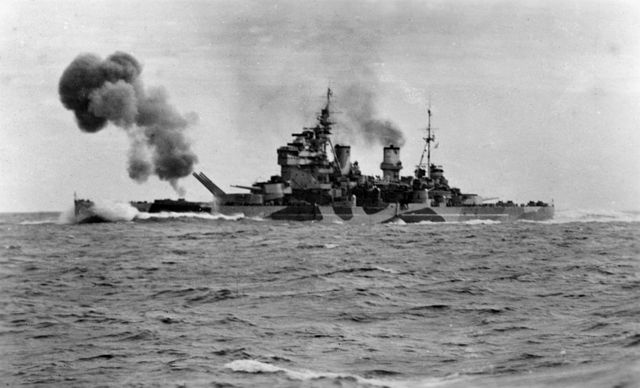
HMS Anson in the north sea 1942, in firing drills, fwd turret at max elevation
There was much criticism about the artillery choice, especially with the hindsight of how things went during the war. Wether it was the disposition, in quad turrets, weight and speed of the shells, rate of fire, reloading time and issues.
When Prince of Wales (PoW) was pitted against Bismarck in May 1941, during her first “pass”, she had 55 out of 74 shells fired (74% success) out, 85% for the second, and 83% for the third, having fired 101 shells out of 128 or 79%. The remainder being loading issues from various causes. King George V (KGV) later was faultless for the first 32 min. and then had the output down to 20% but managed to fire 339 shells in 90 minutes nonetheless. Duke of York (DoY) when pitted against Scharnhorst benefited from nay adjustments and had 66% output, 91% with the first broadside, 446 shells fired in two hours of hot pursuit in bad weather. It seems indeed the twin turret did better with an average of 90% output.
Problems analysed were most acute with PoW, when she helled over to dodge a broadside, when the shell ring rammers foulied the brackets on the hinge trays on he interlock, and ramming was no longer possible until bearing was changed. There was no ramming problem/bearing on Y turret however. The problem was that with the ship’s motion and gravity effects, the shell tended to severely buckle the hinge tray, and thus damaging the revolving shell ring. It was quite a serious problem, which took time to resolve, specially given the absence of spare hinge trays !
It was also attributed to the the failure of the bridge tube flash doors, not locking fully, collapse of shell arresters (central ammo hoists) or small handling mishaps due to the lack of drills, and issues caused by the gunloading hoist control valves were never adjusted as intended by the engineers, and not corrected in drills yet.
The regrettable fact is these issues were learned “on the fly” famously during the Bismarck chase, and although well known for PoW, with civilian workers since on board, they were quite present still for the KGV as well. The DoY still had minor issues even after three years of refinements and modifications. In 1942, all corrections had been done, and gunnery drills reached 96.1% successes so for the admiralty the quad turrets were now “thoroughly reliable”. In fact, the battle of the North Cape report praised the gunnery as “very satisfactory on the whole”, notably because of the better mastery of the gunners thanks to previous drills, to prevent problems or cure them in action.
The main issues were around the shell arresters, which repeatedly failed when the ramming was done precisely when the ship underwent a sudden move into the swell. If passing the arresters, a shell could jam the whole system and 15 min. necessary to correct the issue, crucial in battle. The redundancy of ten guns was compensating, but still. The North Cape performance was no small feat nevertheless, in part due to the no-flash system related to the shell hoists had very narrow tolerances which were seriously tested when the ship flexed and twisted in swells, just enough to cause minor snaps and jammings. By the book, technical tolerance was below one inch (2.54 cm).
Dual Purpose secondary artillery
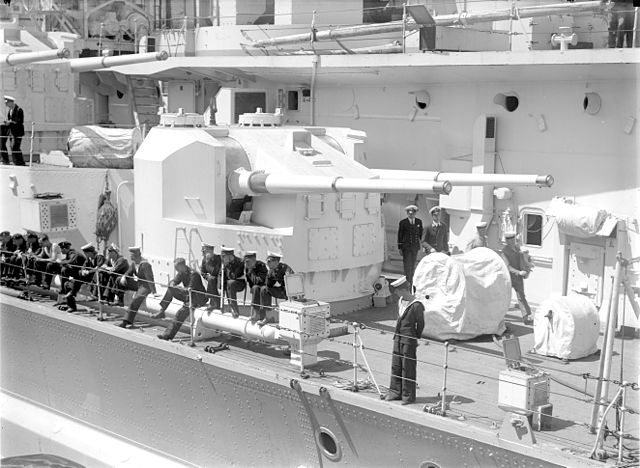
KG V secondary turret
KGV’s secondary artillery was as innovative as the rest of the ship, but it ran into multiple development problems, covered already by the Dido class cruisers study. It was planned to equip all subsequent RN vessel in place of the old 6-in (152 mm) and be versatile to provide long-range AA or deal equally against new generations of motor torbo boats. These compromises led to a disaster in application: In practice they were too slow for effective air defense and too weak to fight off destroyers or more so, engage cruisers while the main battery was reloading. The complexity of the reloading system, shells weight and intensive maintenance produced not the expected 10-12 rpm but in practice rather 7-8 with well trained crews and in the best conditions. They explained in part the POW’s failure to defend herself well in December 1941.
AA artillery (light)
When HMS Anson and Howe were completed, they had six octuple 40mm/39 2pdr QF Mk VIII pompom as well as 18 single 20mm/70 Oerlikon Mk II/IV guns.
The light anti-aircraft defense comprised the usual 40 mm quadruple QF (“pom-pom”) mounts planned already in 1933, and quad Vickers 0.5 in HMGs also planned in 1933 but latter dropped. Both had surface potential for more and in the course of the war, they received 20 mm Oerlikon and 40 mm Bofors, doubling until 1945. On HMS Anson this amounted to 65 x 20 mm and no less than… 216 x 40 mm in various mounts between the octuple and quad Pompom and Bofors, plus single Bofors for some and twin 20 mm mounts. Extra additions went on until 1949. This made them about the best protected battleships in WW2, let down however by the low performance of their 5.25 in DP guns, paling in comparison to the excellent USN standard 6-in/38 twin mount. At some points there were even discussion to replace with these, but the operation would just have been too complex due to their internal ammo supply.
QF 2-pdr
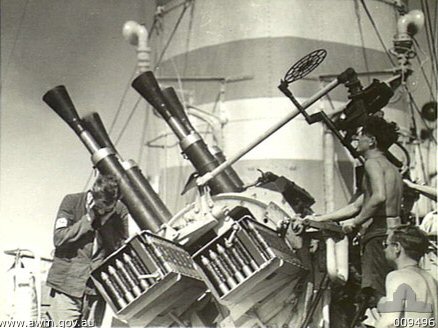
The basic design always included the trusted QF 2-pounder naval gun, of the Mk.VIII when the ships were completed, all in octuple mounts. The four mounts at first were located in upper position yet still close to the secondary batteries below, around the central “island” defined by the split superstructures forward and aft of the transverse catapults. This way, they had a good arc of fire and presented 32, and later 64 barrels in all when four more were added, with 32 barrels covering each side of the ship. This was only the start as they would earn durig WW2 smaller quad pompom mounts and Bofors, with a total almost reaching 200 barrels in 1945.
These QF 2-pdr Mark VIII fired a 1.6 in 40×158mmR shell at 115 rpm and 732 m/s (2,400 ft/s) to 3,960 m (13,300 ft) for the ceiling and theoretical 6,220 m (6,800 yd).
It needed a crew of five, including two loaders passing 14-round steel-link belt.
20-tubes UP AA Mk.I RL
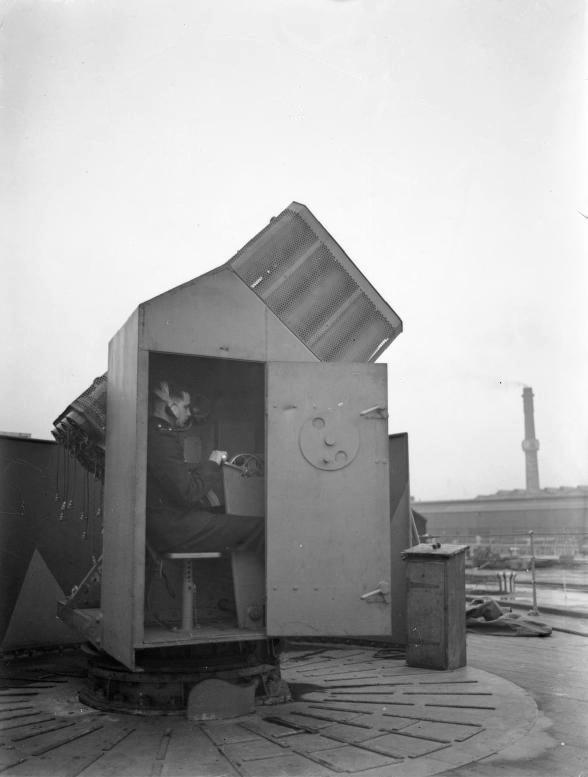
This oddity replaced the initially planned quad Vickers HMGs and were a first on any British Battleships. On 14 November 1939, as First Lord of the Admiralty, Winston Churchill in his first memo requested weekly reports on the rocket development programme. He wanted them on five battleships, and a pair on each of six cruisers plus the monitor HMS Erebus. By April 1940, 40 projectors were ready and started tests. They were fitted on HMS Nelson, Rodney turret’s, HMS Hood, and became mandatory on KGV class when completed, with one of “B”, and one on “Y” turrets. The UP AA Rocket Mark I were to supplement 2-pdr AA guns at close range.
These were 32 inches (81.3 cm) long, weighing 35 lbs. (15.9 kg) with a 3,000 feet (910 m) effectiove range and parachute sinking speed of 16 to 23 fps (5 to 7 mps). The 20-tube mounting weighed 4 tons and had a joint cabin, closed if needed for the operator. The idea was liked by Churchill as innovative but almost totally ineffective as the barrage took too long to establish and was easily avoided by fast aicraft. They were removed at the first occasion on the class.
Fire control
The main guns of the King George V-class ships were controlled via two director control towers:
-One sat top of the bridge superstructure
-One sat aft of the mainmast.
Each was equipped with 15 foot rangefinders.
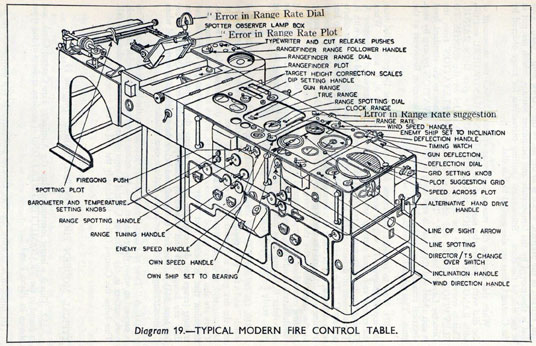
The targeting data was passed onto an Admiralty Fire Control Table Mk IX. The latter was a pretty common system onboard capital ships and cruisers of the RN. The Admiralty Fire Control Table (A.F.C.T.) was an electromechanical analogue computer fire-control system. From the input data, it calculated instantly the correct elevation and deflection of the main armament on the fly, transmitted to the gunner director of each turret. The MK 1 was developed for the HMS Nelson and Rodney, the Queen Elizabeth class and rebuilt battlecruiser Renown had Mk VII tables, but the King George V class had the Mk IX. All succeeded the WWI mechanical Dreyer tables.
If both control towers had been disabled in battle, “A” and “Y” quad turrets had as backup their own internal 41 foot rangefinders. “B” twin turret had a corresponding backup 30 foot rangefinder.
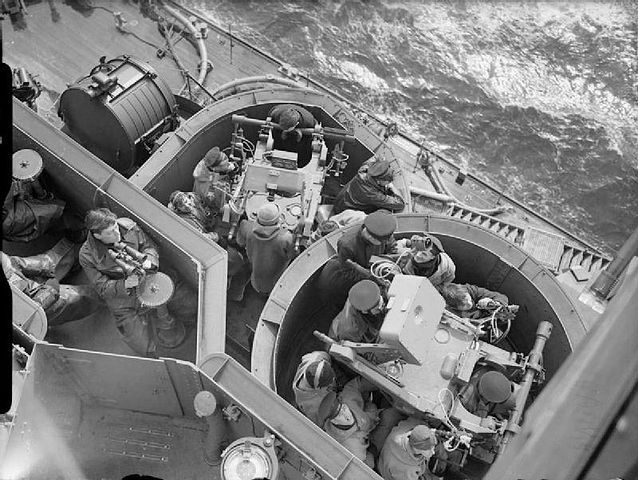
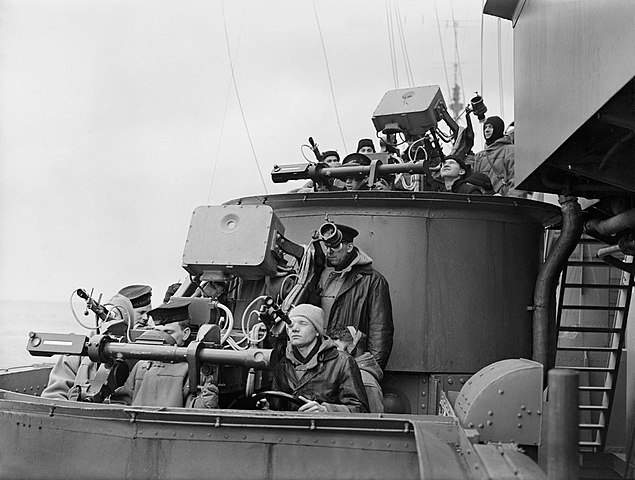
Pompom Mark IV 2-pdr control directors on KGV.
King George V and Prince of Wales also had:
-Four HACS Mk IVGB directors for the 5.25-inch guns
-Six Mk IV pom-pom directors
All of the above featured Gyro Rate Unit for tachymetric fire control.
Duke of York and Howe had updated HACS Mk V directors and HMS Mk VI directors. In time, they were assisted by radar sets and became pretty accurate by late 1944, right in time for the Pacific Campaign.
As completed, these battleships also had radars:
King George V and Prince of Wales had the same early warning type 279 radar, cooupled with the type 284 radars
Duke of York as well as Anson and Howe being completed later, gained an upgraded suite comprising the type 281, type 273, type 284, plus four type 285 and six type 282 radars assisting their main, secondary and AA artillery. This was upgraded during sebsequent years in 1944-45 (see modifications)
Onboard aviation

Back in 1936 when first planned, it seems these battleships were to be equipped with the Fairey Seafox, just in service, but it appeared soon the larger but better overall Supermarine Walrus was found more useful during their construction and they were put into service with these ships at completion. There is no photo to corroborate the presence of the Seafox on any of these battleships.
The interesting fact, as shown in the photo above, was the use of D-III-H back-to-back opposed catapults, two lattice cranes for service, and two hangars in the forward island of the superstructure to house a single Walrus, wings folded each, making for four of them theoretical, with the others on catapults permanently, presumably covered by tarpaulins for water spray. But in reality it was reduced to just two for practical reasons.
There is also navypedia mentioning the Swordfish torpedo floatplane version. At least photos showed it was used on HMS Malaya: Indeed two special squadrons equipped with Swordfish floatplanes, Catapult Flights Nos. 701 and 702. were embarked aboard HMS Malaya in early 1940, assisting the carriers in the North Sea and Atlantic. Another flew over Taranto, and the one on HMS Warspite had a great role in the Second Battle of Narvik, spotting and helping sinking several German destroyers in the fjord. It seems to have been more common on cruisers, but no photos shows it onboard any KGV class battleships as far as i know.
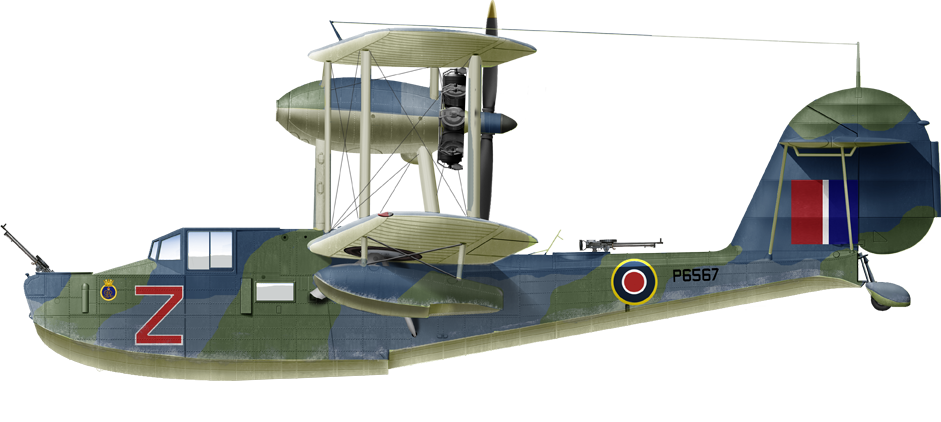
Author’s profile of the Walus aboard KGV: 710 Sqn. “red Z”, P6567 with an interesting three tones camouflage
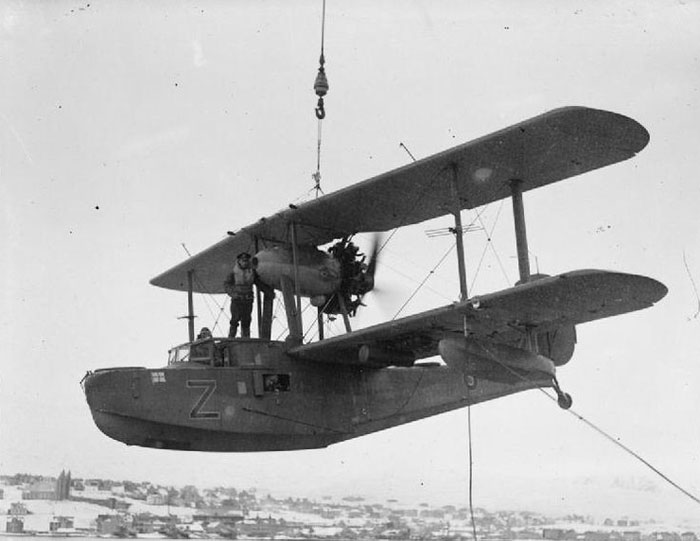
The photo leading to this profile

Interior of the hangar
The Walrus served until late 1944 to early 1945 before being removed, along with the catapults.
Further modifications
Between the KGV, completed in October 1940, and HMS Howe on 17 June 1942, consiferable modifications and improvements had been done, in light of reports from the May 1941 combat of KGV and PoW, but also the loss of KGV in December.
Namely:
-The protection of cable roots for the secondary guns moutings
-Duplicate power for the secondary mounts
-More watertight bulkheads on lower deck neck aft and in the crews wash places
-Blanking on some potential flooding entries like watertight doors, scuttles and ventilation openings
-New, more powerfum Pumping system and deployment of portable pumps plus better drills
-Side lining removed for better access and damage control
-Better isolation of valves
-Emergency battery lighting
-Better management of electrical wiring
-Sleeping accomodations moved from one deck up
-New provision room aft for better flooding control
-Better rudder
-Better isolation of mantles for main and secondary batteries
Electronics upgrades:
King George V got the type 271 radar in 1941, whereas PoW was equipped in May 1941 with four type 282 FCS radars, and four type 285 radars. After the chase of Bismarck in July she receceived also the type 271 radar, while KGV in December was fitted with five type 282 radars.
By mid-1942, King George V received four type 285 FCS radars and one year later HMS Anson was given the type 282 radar. By May 1944 HMS Howe which originally received a full set with the type 273, type 281, type 284 radarswas upgraded to the type 274, type 277, type 281B, with two type 282, type 285 and type 293 radars.
One month later, King George V was upgraded to a new set comprising the type 277, type 279B, 2x type 282, type 285, type 293 radars.
By March 1945, HMS Duke of York, completed originally with the type 273, type 281, and type 284 radars, received a new set with two type 274, one type 277, one type 281B, two type 282, and one type 293 radars, and at the same time Anson had seven FCS type 262 radars, two type 274, four type 275, and the type 277, 281B, 293 radars, but she was also the first to be fitted with the new type 651 ECM suite.
By December, the only change of KGV was the addition of two type 282 radars and a month later in January, she had the following suite: Type 274, type 277, type 279B, nine type 282, five type 285, and a single type 293 radar. Thus became a standard also on DoY and Anson but the first had for example instead eight type 282 FCS, and Anson seven type 262, but also the second ship to receive the type 651 ECM suite. Howe was the last to see her relectronics upgraded, also in January 1946, with the following set:
-One type 274
-One type 277
-One type 281B
-Eight type 282
-Five type 285
-One type 293 radar
Armament upgrades:

The Duke of York in 1945
By July 1941, Prince of Wales was the first to receive three 20mm 178 UP (AA rocket launchers) and two aditional octuple 40mm/39 2pdr QF Mk VIII Pompom.
By late 1941, King George V also received four AARLs, one additional octuple 40/39 2pdr QF Mk VIII, and a quadruple 40/39 2pdr QF Mk VIII, plus eighteen 20mm/70 Oerlikon Mk II/IV (the first to be provided these). Her sister ship received seven of these by December, they were not sufficient to stop the 10 December air attack.
In April 1942, Duke of York received eight 20/70 Oerlikon Mk II/IV and fourteen more in March 1943, while by May, KGV had twenty more and 22 for Anson and Howe by mid-1943.
In May 1944 Howe received only six extra oerlikons 20/70, having also her catapult and seaplanes removed, while undergoing a major uprgade with eventually two quad 40mm/56 Bofors Mk 1.2, two octuple 40mm/39 2pdr QF Mk VIII pompom and four twin 20mm/70 Oerlikon Mk II/IV added. The first to received Bofors.
This was followed in June by Duke of York woth two extra single and two twin 20mm/70 AA and in July for KGV, receiving her first quad Bofors 40mm/39 and twelve 20mm/70, her catapult and planes removed, and then two quad 40mm/56 Bofors Mk 1.2 added, keeping her three Octuple pompom but having six twin 20mm/70 Oerlikon Mk II/IV.
In March 1945 HMS Duke of York on turn had her catapult and planes landed, and from two quad 40mm/56 Bofors Mk 1.2, and two Pompom had six extra quad 40mm/39 2pdr QF Mk VIII added and six twin Oerlikon plus fifteen single. At the same time, Anson was given in two phases (with also removal of planes and catapults), two quad Bofors, two Pompom, then two extra quad Bofors, ten twin and 13 single Oerlikon, two more twin 20mm/70 and two quad Pompom added. Howe when the war ended in Sepember just received 34 Oerlikon guns, eighteen single 40mm/56 Bofors Mk 1.2, and six quad pompom Mk VIII.
After the war in 1946 the standard for AA was siw quad 40mm/60 Mk 2, eight octuple Pompom Mk VIA, eight twin oerlikon 20mm/70 Mk V and circa fifty single.
The very last additions were to have six single Bofors 40mm/60 Mk III added.
⚙ King George V class specifications |
|
| Dimensions | 745 x 103 x 33 ft (227 x 31 x 9,9 m). |
| Displacement | 38 030 t. standard 42 237 t. FL to 40K long tons, 45,360 long tons DL 1945 |
| Crew | 1314-1631 officers and enlisted men |
| Propulsion | 4 shafts Parsons turbines, 8 Admiralty 3d boilers, 110,000 shp. |
| Speed | Top speed 28 knots (52 km/h; 32 mph) |
| Range | 15,600 nmi/10 knots (19 km/h; 12 mph) nautical RA at 18 knots. |
| Armament | 2×4, 1x2x 14-in Mk.VII, 8×2 Mk.I 5.25 in, 4×8 40 mm pompom, 2 walrus seaplanes. |
| Armor | Main Belt 14.7-5.4 in, Deck 4.88–5.88 in, Turrets 12.75 in, Barbettes 12.75 in, Bulkheads 10–12 in, CT 3–4 in |
Conclusion: The King, the Lion and the Vanguard
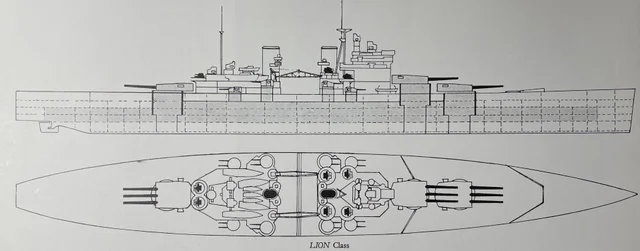
The Lion class (58,000 tonnes FL) sporting three triple turrets with 16-in guns.
It must by said that with all the AA, radars and other additions, despite the removal of their aviation and catapults, and relatively low sheer of the hull (still with a better freeboard midship of 21 feets), they reached almost 46,000 tonnes in 1945 and plowed a lot in heavy weather, wet ships in winter. This low prow was from a requirement to fire at max depression which never happened in practice. In this regards, the Vanguard did better, with more flare and sheer to the bow. Anather critic regarded no the guns themselves, this has been seen in detail, but the main turrets.
Not the fact a twin was mixed with two quads, but the shape of these. The individual cradles allowed all four guns to elevate independently and fire was never completely simultaneous to avoid shell interference. However having slab-sided turrets with “only” 13-in armour seemed a vulnerability. The turrets were even flat at the front. However given the size of the gun cradles and already cramped interior it would have been quite a fit to have these turrets sloped, space was lacking simply put to fit larger barbettes.
The last point, rightly so, was their limited range, due to a total fuel tank capacity equal to the Littorios, and degradation of performances due more to degraded fuel rather than intrinsictly bad boilers or turbines. They could have taken onboard an extra 200 tons of fuel to at least not be ridiculous compared to the Bismarck, which had the better range overall thanks to her nature of long range commerce raider, whereas the KGV was more an “interceptor”. Although understandable in the European “confines”, this became a problem in the Pacific where they were redeployed or scheduled so in 1945.
Despite the shortcomings of her secondary battery, disposition was good, fire control was good, notably the ability to take on four targets at once and rapid swap to antiship fight if needed. Another point, more surprising, is the thinking given to aicraft management (until they were removed on 1944-45 thanks to new radars). The amidship transverse catapult was not an invention as much it was already in use on the rebuilt Warspite, and on the “Town” class cruisers. The placement of the hangars enabled all in all four planes to be managed, bringing a wide bubble of reconnaissance to the fleet and four spotting stations for the main artillery, at least on paper with good weather and no fighters around. The Lions class get rid of them however quite quickly during their final design.
Would the Lion would had been superior ? Based on their main battery of 16 in (406 mm) guns, certainly, both facing what was left of the Kriegsmarine and the IJN. Armour wise it was basically a repeat of the same scheme, and drawings shows a limited flare to the bow, so they would have been probably equally “wet”.

The HMS Vanguard, still most of it sharing DNA with the KGVs, but with oddly WWI-era (modernized) 16-in guns twin turrets.
Profiles

KGV as completed, with her factory-applied camouflage, October 1940 as commissioned.

HMS King Georges V in light grey livery, apparently in Scapa Flow, repainted, January 1941.

KGV in dark grey livery, late 1941

KGV admiralty intermediate camouflage, mid-1943

Prince of Wales with Force Z in December 1941

HMS Howe in July 1944, Suez Canal
Links/sources
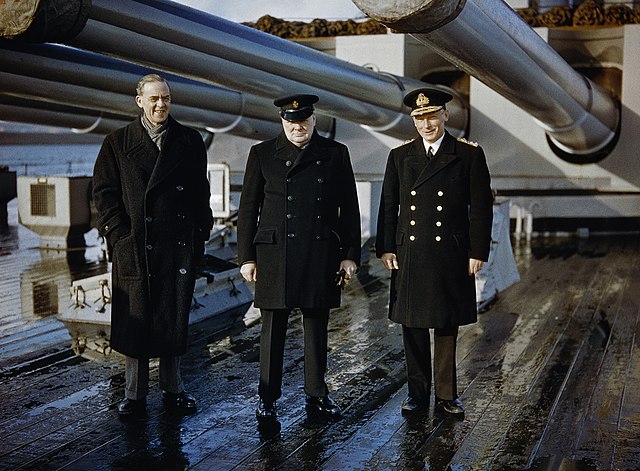
Sir Stafford Cripps, Churchill and Tovey on deck of KGV 11 October 1942 in Scapa
Books
Campbell, N. J. M. (1980). “Great Britain” in Conway’s all the world’s fighting ships 1922-1947
Kagero TD-7017 17 – The Battleship HMS King George V
Brown, David K. (2006). Nelson to Vanguard: Warship Design and Development 1923–1945. London: Chatham Publishing.
Campbell, John (1985). Naval Weapons of World War II. Annapolis, Maryland: Naval Institute Press.
Friedman, Norman (2015). The British Battleship 1906–1946. Barnsley, UK: Seaforth Publishing.
Garzke, William H. Jr.; Dulin, Robert O. Jr. (1980). British, Soviet, French, and Dutch Battleships of World War II. Jane’s.
Johnston, Ian; Buxton, Ian (2013). The Battleship Builders: Constructing and Arming British Capital Ships. Barnsley, UK: Seaforth.
Layman, R. D.; McLaughlin, Stephen (1991). The Hybrid Warship: The Amalgamation of Big Guns and Aircraft. NIP
Raven, Alan; Roberts, John (1976). British Battleships of World War Two. Annapolis NIP
Breyer, Siegfried (1974) [1973]. Battleships and Battle Cruisers 1905–1970. Garden City, New York: Doubleday & Co.
Brown, David K. (1995). The Design And Construction Of British Warships 1939–1945. NIP.
Brown, David K. (2000). Nelson to Vanguard: Warship Design and Development 1923-1945. Chatham Publishing.
Burt, R. A. (2012). British Battleships, 1919–1939 (2nd ed.). Annapolis NIP
Buxton, Ian & Johnston, Ian (2021). Battleship Duke of York: An Anatomy from Building to Breaking. Seaforth Publishing.
Chesneau, Roger. (2004). Ship Craft 2: King George V Class Battleships. London: Chatham Publishing.
Crompton, Samuel Willard (2004). Sinking of the Bismarck. Chelsea House.
Friedman, Norman. U.S. Battleships: An Illustrated Design History. NIP
Garzke, Dulin and Denlay (2009). Death of a Battleship. SNAME Marine Forensics Committee.
Kennedy, Ludovic (1974). Pursuit. New York City: The Viking Press.
Marriott, Leo (2004). Vital Guide Fighting Ships of World War II. Airlife Crowood Press.
Middlebrook, Martin & Mahoney, Patrick (1979). Battleship: The Sinking of the Prince Of Wales and the Repulse. Penguin History.
Miller, Nathan (1995). War at Sea. New York: Scribner.
Konstam, Angus (2009). British Battleships 1939–45 (1) Queen Elizabeth and Royal Sovereign Classes. Osprey New Vanguard. Vol. 154.
Rasor, Eugene L. (1998). The China-Burma-India Campaign, 1931–1945: Historiography and Annotated Bibliography. Greenwood Press.
Raven, Alan (1972). King George the Fifth Class Battleships. Bivouac Books.
Roberts, John (1983). “The Final Action: The Sinking of the Bismarck”. In Roberts, John (ed.). Warship. Vol. VII.
Rohwer, Jürgen (2005). Chronology of the War at Sea 1939–1945: The Naval History of World War Two (Third revised ed.). NIP
Roskill, Stephen (1976). Naval Policy Between Wars. Volume II: The Period of Reluctant Rearmament 1930–1939. London: Collins.
Stephen, Martin (1988). Sea Battles in Close-Up: World War 2. Annapolis NIP
Tarrant, V. E. (1991). King George V Class Battleships. London: Arms and Armour
Links
On navypedia.org
On smh-hq.org
(archive) Bismarck armour
rina.org.uk – Naval architects
navweaps.com underwater projectiles ballistics
hmshood.org.uk report on the loss of Hood
(archive.org) relative protection afforded by the armour of British and foreign capital ships and cruisers against gunfire from various calibres of guns
On naval-history.net
Note 1936 battleship-armament#S5CV0315P0_19360720_HOC_247
archive.org KGV class secondary battery
maritime.org on 14-in guns
USN Projectiles table
British 14-in on navweaps.com
British 5.25 in on navweaps.com
london-naval-treaty-bill-1936
On wikipedia.org for base ref
Videos
A Must see: Most nerdy points in the article are from a rather long and deep video by drachinfels hosting historian Matt Warwick
Guns blazing footage
 HMS King George V (1938)
HMS King George V (1938)
HMS King George V after being commissioned on 1st October 1940, sailed for Rosyth, Scotland on the 16th, to join the Home Fleet, taking onboard her her ammunition supply and start her sea trials. From the Home Fleet at Scapa Flow she made her shakedown cruise at an unknown date but crossed the Atlantic early in 1941 with Lord Halifax onboard as Ambassador to the United States, reaching Annapolis, then covering a return convoy to Scapa Flow, arriving on 6 February. Next she took part in Operation Claymore, covering the landing og Royal Marines on the Lofoten islands, off Norway. She escorted Atlantic convoys HX 104 and HX 115 in March 1941. By May she was to take part in the most sibgnificant even in her career.
The Bismarck Chase
When KMS Bismarck and Prinz Eugen were signalled and started to be tracked on possible ways to reach the Atlantic, HMS King George V sailed out on 22 May with HMS Victorious and eleven cruisers and destroyers to reinforce the interception cruiser on the Iceland gap. The battleship was flagship of the group, carrying the mark of Admiral Sir John Tovey. She ended about 300-400 miles on 24 May, when hearing about the battle delivered by her sister HMS Prince of Wales and Hood, and their fates, with PoW forced to retire and Hood obliterated. The chase was still on.
Bismarck was relocated at 10:30 on 26 May heading for Brest and Rodney by the time had joined King George V, both still too far away to intercept her at 125 miles (201 km). Fortunately, Ark Royal’s air group managed to attack her at 22:25 hitting her rudder notably, so she was forcing back unwillingly. At 15:00 Rodney and King George V speeing at 22 knots arrived on site, with King George V having only 32% fuel left. Tovey signalled his battle plan to Rodney on 27 May before sunrise and she was granted independence of movements while still following King George V. They waited until reaching the ideal range of 15,000 yards (14,000 m).
By 08:43 King George V had Bismarck in her scopes at 20,500 yards. Bismarck straddled Rodney but King George V closed to 16,000 yards (15,000 m) to start firing, and Bismarck concentrated all her remaining guns on King George V, expected her to be the weakest of the two, based on her fight against PoW. But she only caused near misses. At 09:14 KGV started to make hits from 12,000 yards (11,000 m) and even her secondary battery of 5.25-inch guns opened fire while Rodney close to 8,500–9,000 yards and also made many hits.
At 09:27 Bismarck lost her turret ‘Anton’ and after half an hour, King George V started to have issues with her main battery, but Rodney hit steadily meanwhile until 10:21 when the German battleship was silenced. Tovey sent HMS Dorsetshire to finish her off with torpedoes, with allegedly some of Rodney.
King George V fired during this epic engagement some 339 main shells, plus around 700 secondaries. Very low on fuel they were back to the nearest practicable port at 19 knots escorted by eleven destroyers since these waters were in range of the Luftwaffe and patrolling U-Boats. Four German aircraft attack the following day but missed, but HMS Mashona was bombed and sunk.
Northern Convoys
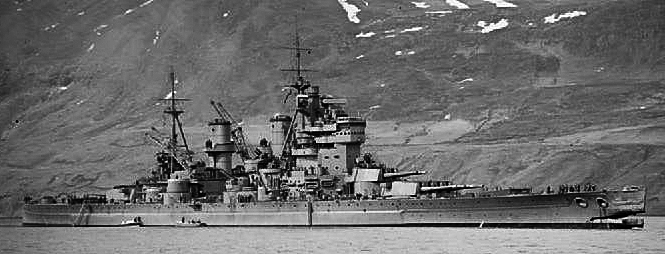
HMS King George V after the collision with HMS Punjabi, tearing apart her bow
After having her guns fixes, HMS King George V took part in the attack of German traffif in Glom Fjord, Norway by October. She was assigned to Murmansk convoy escort and on 1st May 1942 with USS Washington she escorted Convoy PQ 15, when colliding with the DD HMS Punjabi trying to avoid a mine but crossed her bow, in a very dense fog. The unfortunate destroyed was unsurprisingly cut in half, sinking rapidly, while KGV had her bowcut open with a gash 40 feet (12 m) long, all plates ripped off. She entered the Gladstone Dock at Cammell Laird, Liverpool on 9 May for repairs. Back on 1 July 1942 to Scapa she trained there until 18 December 1942, then sent for another escort in the arctic, JW 51A.
Mediterranean campaign
By May 1943, King George V was reassigned to Gibraltar for Operation Husky. With her sister HMS Howe she was allocated to the reserve covering group on 1 July. They both were called to bombard Trapani on the 12th and later to help defend against an air raid when stationed in Algiers. Next they were prepared to take part in Operation Avalanche, the Allied invasion of Italy.
Always together, they shelled the islands of Levanzo and Favignana which had Italian batteries, and were reassigned to the reserve group for the Salerno landings starting on 9 September. King George V escorted later the surrendering Italian Fleet, notably Andrea Doria and Duilio to Malta. She escorted a naval force occupying the naval base at Taranto and later escorted the previously surrendered Italian ships, this time from Malta to Alexandria. She covered the Salerno landings by shelling several German positions during before heading back for home, overhaul and possible reassignment.
Pacific operations
King George V was overhauled in Liverpool in March-June 1944, receiving new radars, more AA and better accommodation, and ventilation (with the rmoval of planes and datapults to make extra room). Thus, she missed D-Day. However after training by 28 October she sailed from Scapa Flow under command of Admiral Sir Bruce Fraser to join the Pacific fleet assembly port of Trincomalee, Ceylon. But before getting there she stopped at Alexandria en route and was redirected to Milos (Aegean Islands) to shell German positions.
On 1 December she crossed the canal and was in Trincomalee on the 15th, departing on 16 January as part of TF 63. She covered the aicraft carriers Illustrious, Indomitable, Indefatigable and Victorious, four cruisers and ten destroyers, covering 11,000 nautical miles to Sydney first, while shelling Japanese-held oil refineries on Sumatra (Operation Meridian). KGV made her first replenishment-at-sea (RAS) while repelling her first Japanese air attack, downing a Mitsubishi Ki-21 “Sally” army bomber and damaging many others.
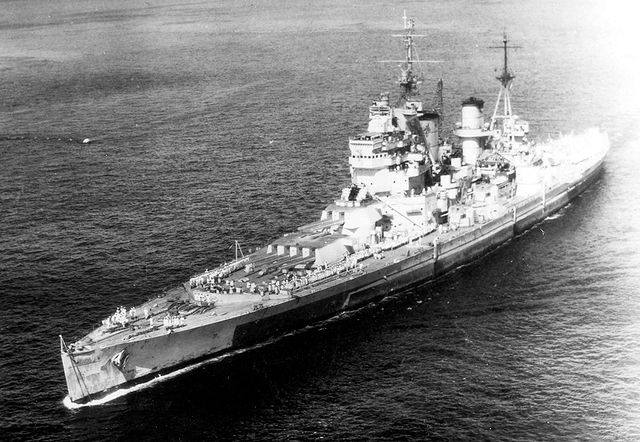
King George V entering Apra harbor, Guam in 1945
When joined by her old Mediterranean companion, HMS Howe the force she was in was re-designated Task Force 57, part of the BPF of British Pacific Fleet. By late March 1945 she shelled Japanese positions on the Sakishimo-Gunto airfields, and again by May. On the 4th, as flagship she led her battle group in a 45 minute bombardment of Japanese air facilities in the Ryukyu Islands. By mid-July she was detached to a bombardment group of US battleships heading for industrial installations at Hitachi. She fired 267 main guns rounds at this occasions, without a single incident, between all past corrections and drills. The task force moved then to Hamamatsu (southern Honshu) for another shelling of aviation factories there (Shōwa Yakuhin, Nakajima Aircraft Company, Suzuki Motors, the IJA Hamamatsu Flight School and airfield). Next this was Operation Iceberg and the Okinawa campaign, covering the aircraft carriers of the British Pacific Fleet. He last wartime action was a night bombardment of Hamamatsu (29-30 July). She replenished and nothing muc happened when learning about the Japanese surrender on 15 August.

HMS King George V at Tokyo Bay, September 1945. USS Missouri and an Essex-class aircraft carrier are visible in the background.
She moved with the British Pacific Fleet into Tokyo Bay so to be present at the surrender ceremonies. Next she returned home, but not before conveying in January 1946 the Duke and Duchess of Gloucester for an official visit to Australia, and back to Portsmouth in March. She became flagship of the Home Fleet until December 1946 and was converted as a training ship, until June 1950, when the government decided to have her and her sister-ships placed in reserve, mothballed, KGV being the first British capital ship to be preserved by sealing the armament, draining all fluids, having all her machinery and boilers cured and covered, installing dehumidifiers. By December 1955, she was placed in “extended reserve”. In 1957 decision was taken to scrap the whole class. King George V in 1958 was towed for her last voyage from Gareloch where she was berthed, to Arnott Young and Co. in Dalmuir for demolition.
 HMS Prince of Wales (1938)
HMS Prince of Wales (1938)
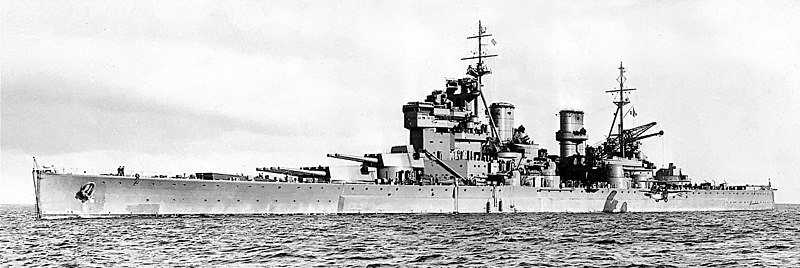
PoW as commissioned in January 1941
HMS Prince of Wales was commissioned on 19 January 1941 and apparently still needed training but never made her shakedown cruise. Her sea trials, followed by gunnery trials meant she still had fixes planned and civilian workers hard at work on 22 May 1941, when she was ordered with the battlecruiser HMS Hood and six destroyers to take station south of Iceland, one of the probable routes for the battleship Bismarck into the Atlantic. On board was her first Captain, John Leach, which knew his main battery was still not ready and had to sail out with Vickers-Armstrongs technicians onboard already during training exercises in Scapa. They were personally requested by the captain to remain aboard, to work on the problems until the last minute. Little they knew what awaited for them.
The hunt for Bismarck (Battle of the Denmark Strait)

Bismarck and Prinz Eugen were reported going south-westward in the Denmark Strait a day later, while Vice-Admiral Lancelot Holland (HMS Hood) ordered 27 knots (50 km/h) all night to take psition as soon as possible. He signalled that both capital ships would focus on Bismarck, Prinze Eugen being care for by HMS Norfolk and Suffolk but the latter were not informed due to strict radio silence. On 24 May destroyers went ahead screeining, while both Capital ships now rushed at 28 knots (52 km/h) – PoW using her engine boosts for the first time – changingd course to obtain a better target angle if and when German ships would arrive. With a 10-mile (16 km) visibility now, action stations was called at 5am, and 37 min later, enemy contact report both inflexed their path at 05:49, having the Germans 30 degrees on their starboard bow, which provented use of their aft turrets. Prinz Eugen was in front of Bismarck, both capable of full broadsides, while Prince of Wales and Hood tried to correct their heading, Hood in front.
At 05:53, Prince of Wales opened fire on Bismarck at 26,500 yards with some confusion as at forst opened fire on Prinz Eugen, which silhouette was close. Her first salvo straddled the cruiser, but thanks to excellent optics and angle, the Hipper-class cruiser managed to score several 8-in hits on Hood while Prince of Wales’s two three-gun salvoes were 1,000 yards over. Her turret rangefinders optics were splashed by spray over the bow as the battleships ploughed heavily so the main 15-foot (4.6 m) tower rangefinders were directing instead, and straddled Bismarck with the 6th, 9th and 13th salvos and two hits. One pierced her bow which crucially had the battleship lossing 1,000 tons of fuel oil plus having salt-water contamination. The other entered below her side armour belt and flooded the auxiliary boiler machinery room, having two boilers shut aft. Both would be decisive factors afterwards but soon fire decreased due to defects and sporadic breakdowns while “Y” (aft) turret jammed entirely.
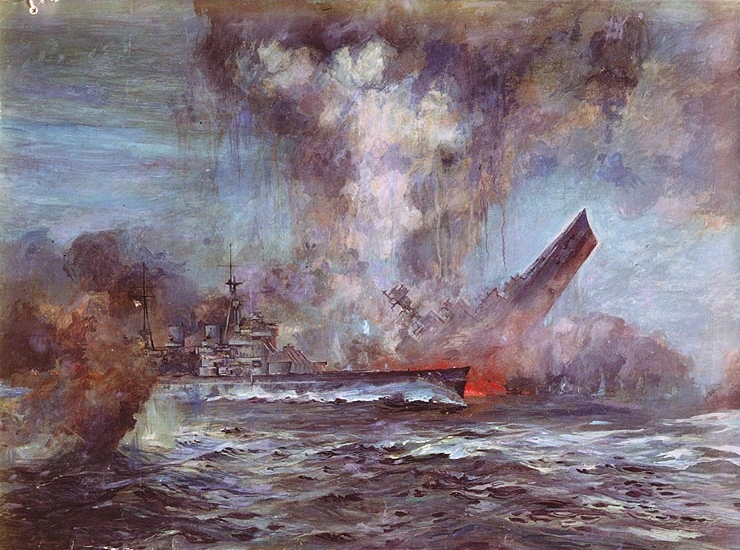
PoW going almost through Hood’s wreck sinking
Therefore the Germans focused on Hood, Prinze Eugen apparently hit a ready service locker for ammunition, the fire spreading, while at 05:58 at 16,500 yards a turn of 20 degrees to port was done to bring the full battery to bear on Bismarck, but Bismarck straddled her fifth salvo hit, with the famous “lucky shell” which took an improbable path and manage to cause a massive internal explosion, destroying the battlecruiser. Prince of Wales made a sharp starboard turn to avoid hitting her, but doing this, entered in a more precarious position, closer to the Germans, but still fired unopposed until turning to port at 05:57, this time taken under an intense, accurate combined fire.
She was hit by a 15-in below the waterline and at 06:02, another hit the starboard side compass platform, killing nearly all personnel, notably the navigating officer was badly wounded. Captain Leach was spared, and he was informed of a dud quite soon penetrating her side below her armour belt amidships, later defused at Rosyth. With his admiral gone, at 06:05 Captain Leach decided to disengage directing destroyers to lay a heavy smokescreen as cover. He radioed Norfolk about the loss of Hood and headed for HMS Suffolk, shadowing the German guant about 15-17 miles astern.
The chase went on until 18:16, contact lost and regained by Suffolk at 22,000 yards which gave her Prince of Wales another chance of hitting Bismarck, but from 30,300 yards (27,700 m), firing 12 salvos which all missed.
The Argentia Conference

HMS Prince of Wales off Argentia Newfoundland in August 1941
At 01:00, 25 May, Prince of Wales regained contact, opened fire at radar range (20,000 yards in pitch black), but “A” turret temporarily jammed. This was her last exchange, the Bismarck was lost and the British lost trace for 12 hours while Leach headed for Iceland. His battleship had 30 dead, 9 wounded, but all the workers were safe. They were quite happy to hit land again. On 6 June in dry dock the unexploded shell was removed by a Bomb Disposal Officer. Repairs at Rosyth done, she carried PM Winston Churchill across the Atlantic for a secret conference with Franklin D. Roosevelt, coming on 5 August aboard USS Augusta and the presidential yacht Potomac. On 7 August, the yacht separated, used as a decoy, cruising New England waters. On 9 August, the conference took place in Placentia Bay, Newfoundland, on board Prince of Wales and later until 12 August aboard Augusta, with the Atlantic Charter proclaimed.
With Force H
By September 1941, HMS Prince of Wales was reassigned to Force H, Mediterranean, Group II (Vice-Admiral Alban Curteis) with HMS Rodney and the cruisers Kenya, Edinburgh, Sheffield, Euryalus plus twelve destroyers, all deployed for Operation Halberd, an important and early supply convoy from Gibraltar to Malta. On 27 September, Italian air attacks were repelled by Prince of Wales which had several kills. Reports of the Regia Marina en route to intercept had both POW and Rodney scrambled with Ark Royal in interception, but missed. The operation was successful and PoW was back in Gibraltar. There, she was ordered back to Scapa Flow, arriving on 6 October.
With Force Z and fate
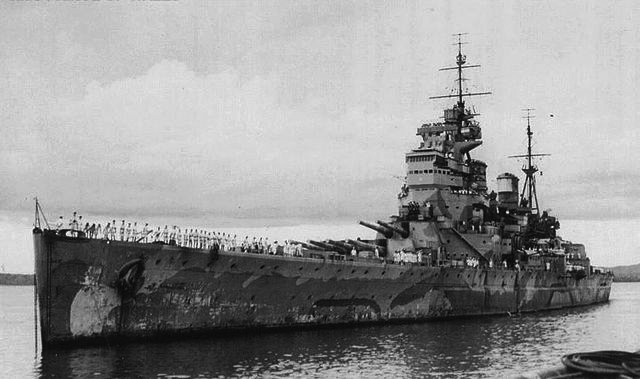
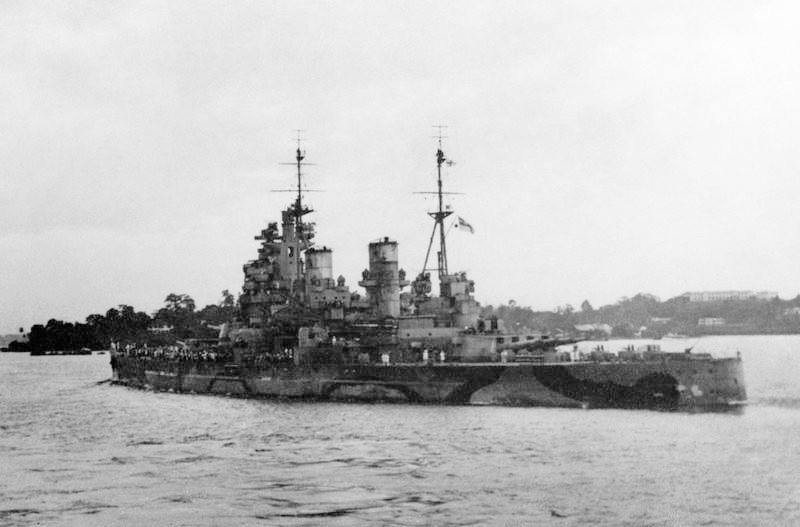
HMS Prince of Wales in Singapore
On 25 October, HMS Prince of Wales was reassigned to a new defence force tasked to defend Singapore as the Japanese intensified operations. She sailed with a destroyer escort, not via the Mediterranean and Suez canal but Freetown and the Cape, South Africa, rounding Good Hope and resupplying there. She later stopped in Mauritius and the Maldive Islands while proceeding to the Indian Ocean to meet the battlecruiser HMS Repulse. The aircraft carrier Indomitable was also committed, but she ran aground off Jamaica and had to be repaired. Her presence could have change everything.
She reached Colombo in Ceylon, on 28 November 1941, joining Repulse and on 2 December, both arrived in Singapore harbor, Prince of Wales becoming flagship of Force Z under command of Admiral Sir Tom “thumb” Phillips. Sir John Tovey had opposed this decision from Churchill as believing she was not designed either for the pacific or tropical climates. Both the city defence were bolstered however and the arrival of Force Z was a massive morale booster for the local population.
Meanwhile a Japanese troop-convoy was signalled on 6 December. The following dayn the attack on Pearl Harbor took place, and Britain knew she was likely next on the menu. Japanese aviaiton raised Singapore undeed on the 8th, Prince of Wales’s AA veing mostly inefficient. On signal from the Admiralty, and with confidence he would be covered by the local RAF, Admiral Phillips scrambled Force Z (with the escort destroyers Electra, Express, Tenedos and HMAS Vampire) to fell on the Japanese transports at Kota Bharu.
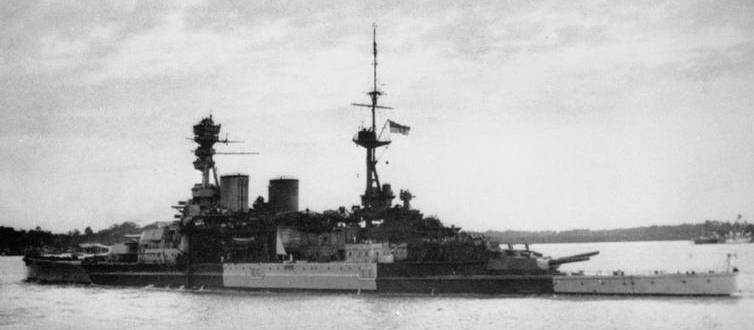
HMS Repulse leaving Singapore
In the afternoon however, the Japanese submarine I-65 spotted them, and later their position was again confirmed by Japanese aerial reconnaissance. Admiral Philips called for RAF fighter support, but it was denied, and at midnight Japanese forces landed at Kuantan in Malaya, forcing Force Z to divert there, spotted again on this new course at 02:11 on 10 December by another submarine. At 08:00 both arrived off Kuantan to learn this was a diversion, and Philips was now out of range of any air support and feared a very probable Japanese attack, as he was where they wanted.

Author’s rendition of the Mitsubishi G3M3 model 22 which was part of the attack, equipped with external bomb racks
He only waited for two hours, as at 11:00 lookouts signalled eight Mitsubishi G3M “Nell” Navy Bombers incoming. They took formation and dropped close to Repulse. A bomb crossed her hangar roof and explodeded, tearing out her main deck below. Soon a second wave came, this time with 17 “Nells” armed with torpedoes, hald an hour later. They immediately took a pincer formation, splitting in two nine-strong simultanous side attacks in order to avoid bioth capital ships dodging their torpedoes. Prince of Wales was ably manoeuvered though, and only was struck by four torpedoes, but her ASW protection held, Repulse on her side avoided all seven torpedoes dropped and many bombs from six more “Nell” bombers arrived minutes later.
The only torpedo which did damage, hit PoW abaft “Y”, destroying the outer propeller shaft, so that the still spinning shaft now loose went tearing down her bulkheads all the way to B Engine Room. The flooding was soon uncontrollable while her aft electrical system failed, in turn stopping dead all her aft AA. Damage control failed too and she took soon a heavy list, slowing down meanwhile. More attacks however came, with another wave of torpedo-equipped “Nell”, this time against Repulse, which dodged them all.
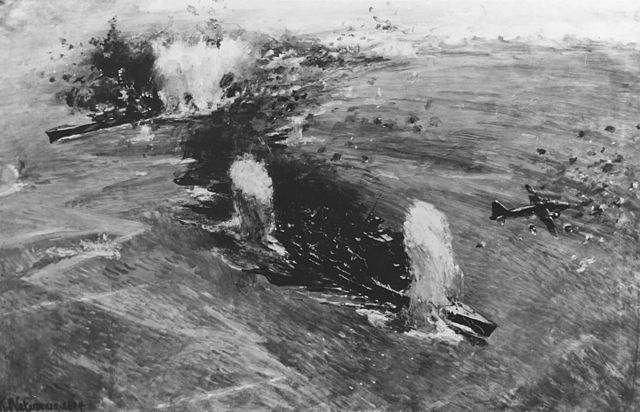
Painting of the attack
PoW could have still being saved at this point, until came a fourth attack, this time with Mitsubishi G4M “Betty”, larger Navy bombers. Using again the pincer tactic, this time to perfection, they prevented manouevers from Repulse, which took several hits and sank later at 12:33. Six others attacked Prince of Wales, scoring three torpedoes which only aggravated the flooding. Her coup de Grace was a single 500 kg (1,100 lb) which went through her catapult deck, down to the main deck to explode ravaging the makeshift aid centre here. Other bombs scored “very near misses” which further fragilized the hull, popping rivets, shearing hull plates which only increased the flooding. At 13:15 Philips was conformed b the Captain in ordering to abandon ship. But just five minutes afterwards, the crippled battleship capsized to port. She floated with her underbelly exposed for a brief moments whereas the last pocket of aire were filled, and sank stern first, carrying with her both Admiral Phillips and Captain Leach, plus 327 sailors and officers.
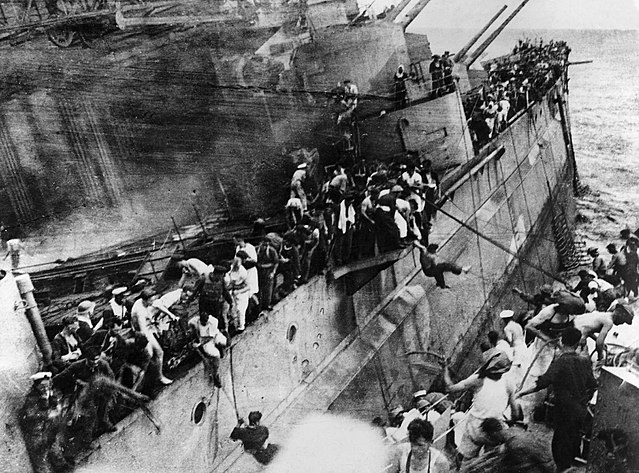
PoW sinking after abandon ship order
Taranto had shown what air power could do on anchored ships, confirmed at Pearl Harbor, but a mere few days after, they claimed the first capital ships on open sea. Among other things to blame, one point feared by Tovey was the failure of her surface-scanning radars due to the humid climate. Her AA did well despite the limitation of her secondary guns, her ASW protection held firm, but it’s mostly the unlikely damage to her shaft that created a disaster as well as the loss of power, halving her operating AA and disabling her electric pumps, aggravated by total darkness in which the damage repair parties operated to counter flooding. In fact an inquiry chaired by Mr. Justice Bucknill was held after the war with divers examining the wreck, but the controversy still is vivid.
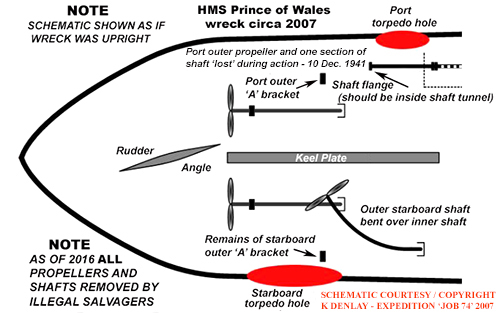
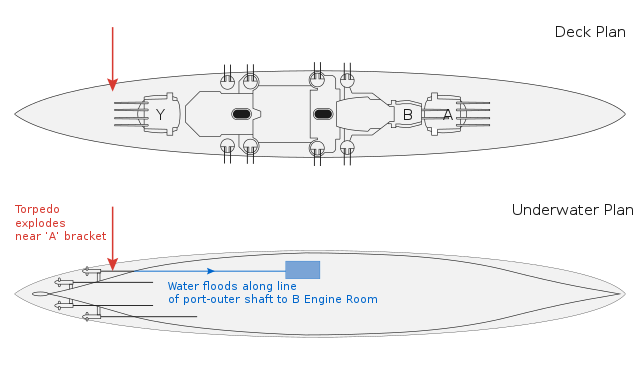
Torpedo Damage assessments, including K Denly scheme of expedition Job 74.
Immersed under 223 feet (68 m) her position his parked since by a Navy White Ensign attached to a line on a buoy, and is a ‘Protected Place’ from 2001. Her bell was manually raised in 2002, restored, and is now in the National Museum of the Royal Navy (Portsmouth Historic Dockyard). The May 2007, Expedition ‘Job 74’ relaunched the debate after nailing the exact location and number of torpedo hits. This led to a scientific paper, “Death of a Battleship: A Re-analysis of the Tragic Loss of HMS Prince of Wales”, presented at a meeting of the Royal Institution of Naval Architects and the Institute of Marine Engineering, Science & Technology in London in 2009 and in New York in 2011. However by October 2014 it was reported both wrecks had been “extensively damaged” by scrap metal dealers.
 HMS Duke of York (1940)
HMS Duke of York (1940)

HMS Duke of York as completed
The third of the “Royals” (Howe and Anson were named after famous ancient admirals), HMS Duke of York was Completed and Commissioned on 4 November 1941, apparently without much delays onlike her two later sister ships. As KGV and PoW, she had her fair share of celebrity in battle.
US War Conference
By mid-December 1941 after initial training and short shakedown cruise, she was tasked to carry PM Winston Churchill for his official trip to the US and a conference with President Franklin D. Roosevelt, after war with Japan just erupted. The battleship dropped anchor in front of Annapolis, Maryland on 22 December to land Churchill and departed for her first true shakedown cruise to Bermuda, in January 1942. As the conference concluded she was ordered to return to Scapa Flow on 17 January, Churchill taking a plane instead.
Arctic convoys

HMS Duke of York during an Arctic convoy March42
On 1 March 1942, she escorted the Murmansk-bound Convoy PQ 12 closely (not distant like her sister Howe for example) together with the battlecruiser HMS Renown, under escort of the cruiser HMS Kenya, and six destroyers. On 6 March, the convoy escort was joined by King George V and HMS Victorious, plus the County class cruiser HMS Berwick, and six destroyers. This reinforcement came from Admiral John Tovey’s order, worried about the presence of Tirpitz in these waters. This proved well-founded. On 6 March indeed, the “lonely queen of the north” was spotted by a British submarine around 19:40, but all the RN, too far away could do, was to launch an unsuccessful aerial torpedo attack.
Later in March she escorted Convoy PQ 13, which went on without incident. By early April 1942, HMS Duke of York and her sister King George V plus Victorious patrolled between Iceland and Norway this tilme in distant cover of more convoys. By late April KGV’s bow was badly damaged by a collision with Punjabi and replaced by Duke of York. She escorted Convoy QP 13 in May with USS Washington and by mid-September QP 14.
Duke of York’s Mediterranean Campaign
Duke Of York leads Nelson, Renown, Formidable, and Argonaut during the occupation of French North Africa
From October 1942, Duke of York was reassigned sent to Gibraltar and force H as flagship. Her first mission was to supported Operation Torch in North Africa by November, being under air attack by the Regia Aeronautica, but never seripusly threatened and repelled with ease on several occasions. Her AA gunners in fact rarely had the occasion to fire a shot as the aircraft umbrella from HMS Victorious, Formidable and Furious was quite dense and efficient.
After this campaign, HMS Duke of York was back home for a refit, and when completed she returned to Force H from 14 May 1943, replacing King George V and Howe which departed to cover Operation Husky in Sicily.
Duke of York’s Norwegian Campaign
Instead she took part in the less famous Operation Gearbox in June 1943:
This was essentially a northern sweep with her, her sister HMS Anson, and the USS Alabama and South Dakota. They were deployed in distant cover for landings and raids in Spitsbergen and the Kola Inlet, followed by diversionary operations (Operation Camera, Operation Governor), off Norway, draw German attention away from Operation Husky. On 4 October, with HMS Anson, she covered Allied cruisers and destroyers escorting USS Ranger for Operation Leader (explained a greater detail in Howe’s part), raiding German shipping off Norway and taking the temperature of German preparations and response here. Four German merchant ships were sunk, seven badly damage and grounded for some, which was not bad from a single, small carrier group.
Versus Scharnhorst: Battle of the North Cape
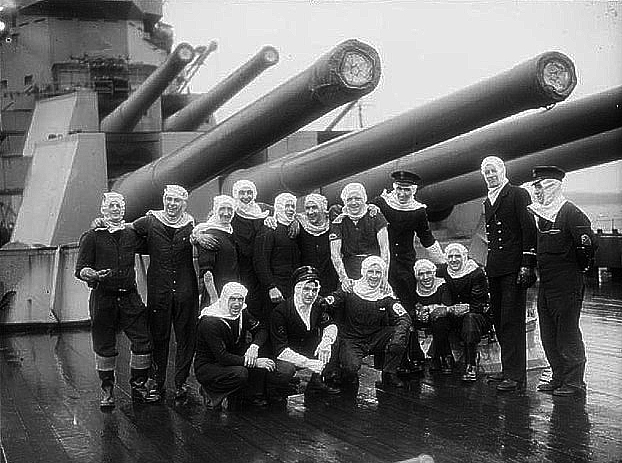
HMS Duke of York’s gunners proudly posing after their fight against Scharnhost
In 1943, Hitler agreed to Dönitz’s decision, which saved the German surface fleet, to relocated them, notably KMS Scharnhorst, to Norway, closer to the Arctic convoys to Russia. Thus they would play a more important role directly helping operations on the eastern front instead of vain attempts to breakout in the Atlantic. Among ships deployed in these Fjords of occupied Norway, several ships like the cruisers Lützow, Admiral Scheer, some heavy cruisers, and Tirpitz, but also the “terrible twins”.

Scharnhorst and Gneisenau: Both had been authorized right after the anglo-German naval treaty of 1935 and had a great speed, nine 28 cm guns, but moderate protection, making them more battlecruisers than fast battleships. Long story short, KMS Scharnhorst, alone to be deployed as her sister was bombed-damaged after a raid and in repairs, was a worthy adversary for a KGV class battleship: She was outranged on paper, but since the British preferred to close to 16,000 Yds to engage, this was equalled. She was faster (31+ knots) compared to 27-28 knots, but protection was certainly not on par. In bad weather, telemetrics and i turn ballistic calculations were not optimal anyway for high scores. An important factor was that Duke of York at the time, unlike KGV and especially DoY, had an experienced crew and most issues with the main gunnery had been resolved, in part by drills. However initialy the real fear was an encounter with Tirpitz, a much serious proposition, or even worse, both together.
This heavy presence of the Kriegsmarine in these fjords forced the Royal Navy to provide heavy escorts. One such ship was spotted by the Germans in early December 1943, so a heavy deployment was expected by allied intel against Convoy JW 55B. Forces 1 and 2 were assigned in distant cover, departing from Loch Ewe on 22 December. On Xmas eve, 25 December, KMS Scharnhorst was reported at sea, escorted by the destroyers Z-29, Z-30, Z-33, Z-34, and Z-38. Force 1 (County class Heavy Cruiser HMS Norfolk, Town-class HMS Belfast and Sheffield, made contact shortly after 09:00, 26 December.
A short engagement followed, but at least one cruiser landed two hits on Scharnhorst, destroying her radar controls. This would have severe consequences in what happened later. The German battleship could expect keeping its distance and fight cruisers, but not a battleship, expecially in a worsening weather. Scharnhorst lost advantage of her greater range in this early clash and fearing a bad encounter, she turned away at full speed after a second brief skirmish in which Norfolk which hit and partly disabled. Rear Admiral Erich Bey aboard Scharnhorst sent his escorting destroyers in an attempt to prey on Convoy JW 55B, and reporting it since no aicraft reconaissance was possible in this weather. Her ordered Scharnhorst’s captain to proceed back to Altafjord, Norway.
But in the meanwhile, Force 2 (Duke of York, Jamaica and four destroyers, Saumarez, Savage, and Scorpion plus Norwegian Stord) manoeuvered already in a pincer, unwknowingly to Bey, and estimated contact at around 17:15. Scharnhorst was picked up by Belfast, shadowed for some time, reported to Force 2, but she altered course, also reported. HMS Duke of York had her own radar radar lock at 16:17 from 45,500 yd (41,600 m) -Schanrhorst was “blind” at this point- and started to manoeuvre for a broadside fire while destroyers went forward for a torpedo run.
HMS Belfast fired star shells at 16:48, illuminating Scharnhorst for what would became a textbook attack.
Duke of York ordered her own 5.25 in (133 mm) to fire star shells in turn, and Scharnhorst was surprised at relatively close range, with her main battery trained on contrary angles. At 16:50, Duke of York was now down to 12,000 yd (11,000 m) when opening fire, a full broadside, which landed a hit right away. Scharnhorst returned fire and at first straddled the British battleships several times, not capable of a more precise fire until she landed tow hits. One 28.3 cm (11.1 in) shell went through the mainmast port leg, a dud, but of which fragments destroyed the electric cable for the main search radar. She was “blind” in turn of the German battleship was fleeing, and gunners now relied on direct vision data. Scharnhorst was close enough to also fire her secondary battery and landed a 15-cm shell in the port strut of DoY’s foremast, also a dud.
At 16:55 Duke of York silenced Scharnhorst’s forward both main battery turrets Anton and Bruno with a single hit in between. However while being at 31 knots when possible, the German battleship opened the distance at 18:24 to 21,400 yd making a ceasefire by default of a good visibility. The DoY had spent 52 broadsides, but what really changed the game, as Scharnhorst was about to disappear from view and a very last broadside lucky hit that landed below her armour belt, completely destroying her longitudinal bulkhead and flooding quickly her No. 1 boiler room. This was what just needed to slow her down enough for a fight to the finish all British sailors prayed for, or at least to be catched -like greyhound dogs- by British destroyers.
The latter indeed at 18:50 were in good position and launched a 28 torpedoes broadside. They hit four times. Scharnhorst was now really flooded, and slowed down even further to the point she was now easy meat for Duke of York that spotted her and fired at 19:01 Duke of York, assisted by HMS Jamaica from just 10,400 yd (9,500 m), the minimum due to the appealing visibility. At 19:15, Belfast joined the chase and started firing, until they were both close enough to fire their own remaining torpedoes.
Meanwhile, DoY landed at least ten more main battery shells on her, silencing most of the secondary battery after the main one. By 19:16 she was moslty silent, in flames and at 10 knots. Cease fire was ordered at 19:30 to close on Scharnhorst. No longer a threat but still afloat, it was ordered to finish her off with more torpedoes, coming this time from Force 1 destroyers, Matchless, Musketeer, Opportune, and Virago, firing all 19 torpedoes. She listed to port and capsized at 19:45. The “battle of north cape” has been a 10 hours chase. Only 36 survivors were picked up, and this had an effect of British naval power maintained off Norway, which can be downgraded a bit for each convoy.
After the battle, on 29 March 1944, Duke of York left Scapa Flow again to escort Convoy JW 58 in the Arctic. She later took part in distant cover to carriers raides against Tirpitz, notably Operation Goodwood, a serie of air strikes in August. By September she was recalled home for a major overhaul.
Duke of York with the BPF
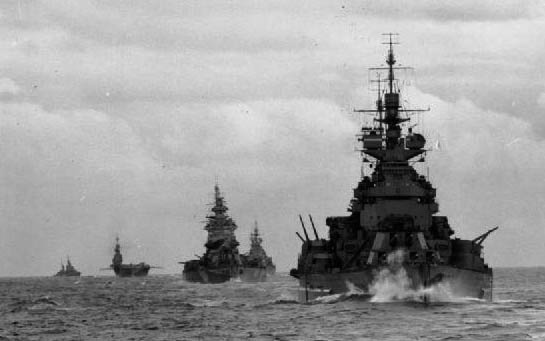
Duke of York
Warships of the U.S. Third Fleet and the British Pacific Fleet in Tokyo Bay, 28 August 1945, preparing for formal Japanese surrender. Duke of York lies just beyond USS Missouri in the fore. Mount Fuji is in the background.
In September 1944 she was overhauled and partially modernized at Liverpool, received considerable AA addition, removal of her aviation, new, upgraded radar equipment and after post-refit refresher training and drills, she was ordered to join the British Pacific Fleet (BPF) where she would met the rest of the class soon. She sailed indeed in company of HMS Anson, on 25 April 1945. However she developed issues with her electrical network on her way to Suez and had to be repaired in Malta. As a result, depite taking the “short way”, she arrived at Sydney only by 29 July, very late for operations although it was no known fully at the time.
By early August indeed, HMS Duke of York departed for her last wartime mission, joining Task Force 37 to escort the four aircraft carriers of the BPF. She joined HMS King George V and from 9 August, joined in turn three American carrier task forces on their way for the final air raids on Japan until 15 August. After the surrender, she sailed with KGV to Tokyo Bay, being present in great regalia for the surrender ceremonies.
In October 1945, she sailed for Hong Kong, this time to join the fleet accepting the surrender of the Japanese garrison here, and became flagship of the British Pacific Fleet until June 1946. Afterwards she was ordered to Plymouth, and a major overhaul. After this she became flagship of the Home Fleet and performed peacetime service duties until April 1949. Laid up in November 1951 she was preserved long-term, until 18 May 1957. She was sold for scrap to Shipbreaking Industries, Ltd., in Faslane. Like her sisters, her bell was salvaged, now on display at the Duke of York School in Nairobi, Kenya.
 HMS Howe (1940)
HMS Howe (1940)
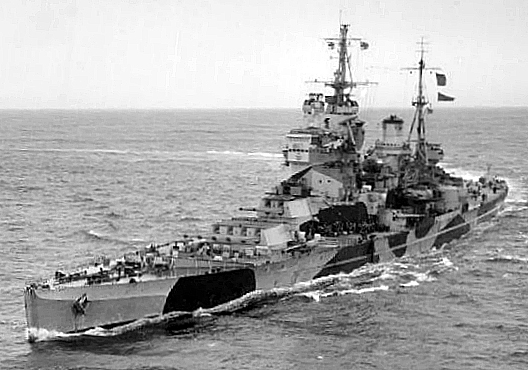
HMS Howe underway at sea, circa 1943
HMS Hower was Commissioned on 29 August 1942, despite she was completed on 31 March 1941. Why so late ?
Her building time extended with redirections of personal and materials to more urgent demands not only of the industry in general but of the yard itself. Fairfield Shipbuilding in Govan, Glasgow, was already indeed busy repairing existing vessels. In late 1941 demands for destroyers in particular was more important than battleships, and aircraft carriers had all priority: Indeed, the Colossus class aircraft carriers were just started from June 1942, HMS Theseus being just laid down in July and the larger fleet carrier HMS Implacable in construction had all priority.
Arctic Campaign
HMS Howe joined the Home Fleet on 30 August 1942 at last, making her shakedown cruise and early training on the way to Scapa Flow. She was trained to escort norther route convoys, in the perilous Arctic waters. On 31 December she paired with her sister HMS King George V for convoy RA 51, inbound from Russia empty in Loch Ewe on 9 January 1943. Both also covered the conoy RA 53 fom 1 March 1943, rescuing merchantmen from vessels sunk along the wat.
Mediterranean Campaign
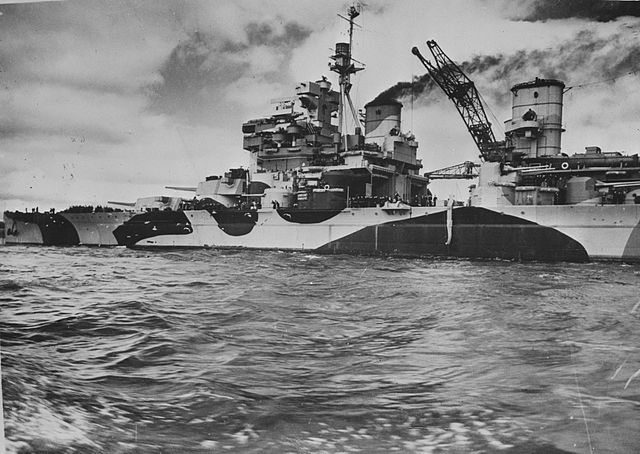
In 1943 Howe was reassigned to Gibraltar, again pairing with HMS King George V and prepare for Operation Husky, in Sicily, being replaced in the home fleet (in case of a sortie of Tirpitz) by USS Alabama and South Dakota. The two battleships concentrated their bombardment on the Trapani naval base, and on Favignana on 11–12 July. They were sent in Algiers to resplenish, when caught by a Luftwaffe attack, which they repelled.
Next they were assigned to the bombardment group of Operation Avalanche (Landings at Salerno) from 7 September. Their fire was appreciated during the progression inland and to repel counter attacks. The Italian surrender was a victory, and on 14 September both escorted the battleships Vittorio Veneto and Italia to Alexandria, after a stop in Malta.
By late October 1943, Howe and King George V went back home for resplenishment and overhauls, plus the crew’s rest during the year’s end. However was drydock for some time in Devonport, having her anti-aircraft battery buffed up, aviation retired, new radar sates, and since she was condidered “wet” like the others, the watertight integrity of her bow, but stern also, was improved. Officers and crew quarters were extended and new accomodations provided and adapted for tropical climate. Indeed, they were scheduled to be sent in the Pacific. Insulation and Air-conditioning throughout the ship was installed or improved.
Howe’s Pacific operations
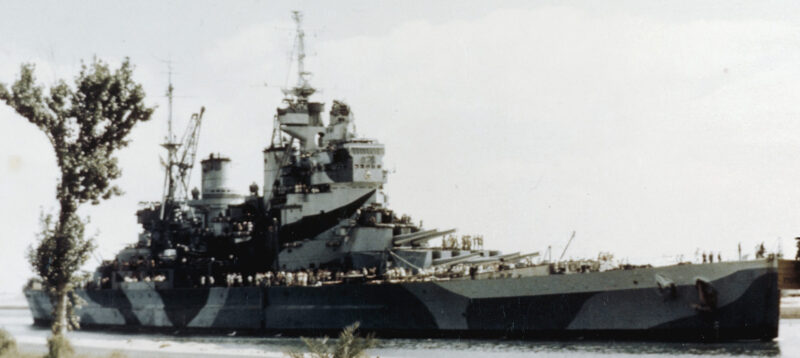
On 8 August 1944, HMS Howe was in Trincomalee, Ceylon, not coming like KGV from South Africa but by the Suez canal, arriving much earlier. There, she joined the Eastern Fleet, as the first modern British battleship deployed in this theater since the Prince of Wales. Her first mission was to provide escort for carriers launching raids on various Japanese strongpoints and objectives in Sumatra. By December 1944, she was sent for the first time to Sydney, then stopped in Auckland to show the flag and for the crew’s rest. By February 1945, after some refresher training, she was paired again with her old mate HMS King George V, arrived in between, in Sydney to start operations with the USN and the newly created BPF. Both battleships were to provide the heavy escort of four carriers, and were assisted by five cruisers and fifteen destroyers, all together called Task Force 113.
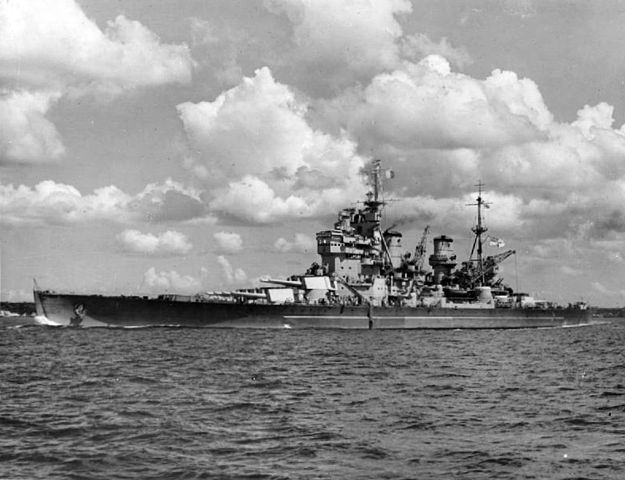
HMS Howe in Auckland, February 1945
Redesignated later TF.57, her unit was to take part in Operation Iceberg , the invasion of Okinawa, and she provided with KGV offshore support during the US landings from 1 April 1945. Both has sufficient AA to repel sometimes massive Japanese kamikaze attacks. Each time she shot down many and remained unscathed. Howe had at least one confirmed and several damaged. In between providing close air defence, past the CAPs, they went on with their routine of land bombardment, very accurately, thanks to spotters and radars. Howe notably flattened Japanese anti-aircraft on Miyako island, close to Formosa (Taiwan). Okinawa was her last campaign.
Post war service
In June 1945 instead of taking part in the Home Island campaign with the BPF and USN, HMS Howe was sent to Sydney for resplenishment and rest, but also a through examination of her general state. It was decided to send her for a refit in Durban, South Africa. She was still there when her captain learned about the Japanese capitulation on 15 August. After Durban, she never returned to the Pacific and instead saild home, to Portsmouth, arriving on January 1946. Her postwar service was limited, and by 1951, she was in reserve, preserved for long term at Devonport. By 1957 the admiralty decided her time has passed and she was to be scrapped, towed on 27 May 1958, to Inverkeithing, Thos. W. Ward for this. Her bell survived, now a turntable at Dounreay nuclear laboratory.
 HMS Anson (1940)
HMS Anson (1940)
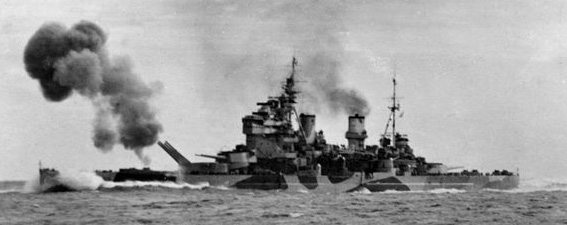
HMS Anson firing guns in North Sea c1942
Arctic Convoys
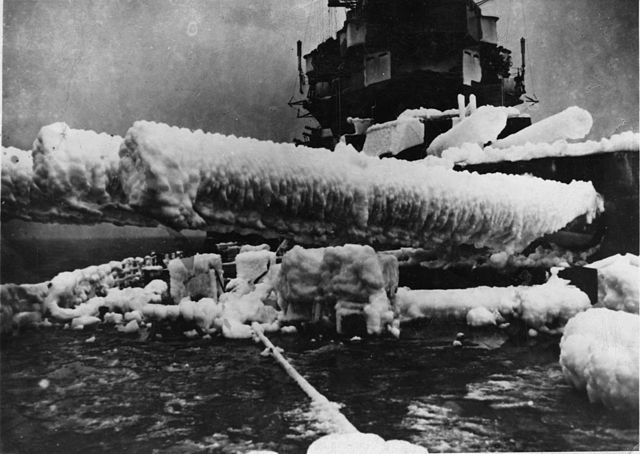
Arctic convoys, winter 1941, pack ice clogging her decks, making her ploughing even deeper in bad weather.
After her commission on 14 April 1942 (Her completion date was posterior, 22 June 1942) she was actually in commission three months before being fully operational, and after a training cruise and extra gunnery drills, she wass sent to the Arctic with many other Home Fleet vessels in escort duties for convoy escort. On 12 September 1942 she covered (at a distance) Convoy QP 14, with her sister HMS Duke of York and the cruiser HMS Jamaica plus the destroyers HMS Keppel, Mackay, Montrose and Bramham. On 29 December she did the same with Convoy JW 51B together with HMS Cumberland and the destroyers HMS Forester, Icarus and Impulsive.
On 23-24 January 1943 same mission again with Convoy JW 52 along with HMS Sheffield, destroyers HMS Echo, Eclipse, Faulknor, Inglefield, Montrose, Queenborough, Raider and the Polish Orkan. On 29 January, the return convoy RA 52 from Kola was covered also by her, with the destroyers Inglefield, Oribi, Obedient and the Orkan on 30 January until reaching Scotland.
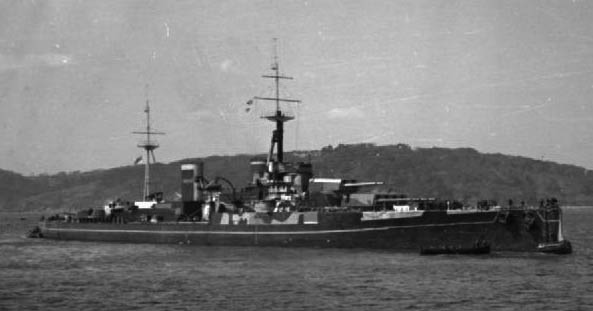
HMS Centurion masqueraded as HMS-Anson
Mediterranean Campaign

In June 1942, knowing German secret services assumed she would go on in this task, the old dreadnought HMS Centurion (of the previous KGV class) was masqueraded to look like her in Scottish waters, offered to Luftwaffe reconnaissance, in order for Howe to depart by night and proceed to the Mediterranean Sea. There she was reassigned to Force H to take part in the secret Operation Vigorous.
By July 1943 Anson she was part of a diversionary move, drawing axis attention away from preparations for Operation Husky. So unlike her sisters she never fired her guns for a coastal bombardment. The operation being over, she was returned home and was prepared for Operations in Norway.
Norwegian Campaign
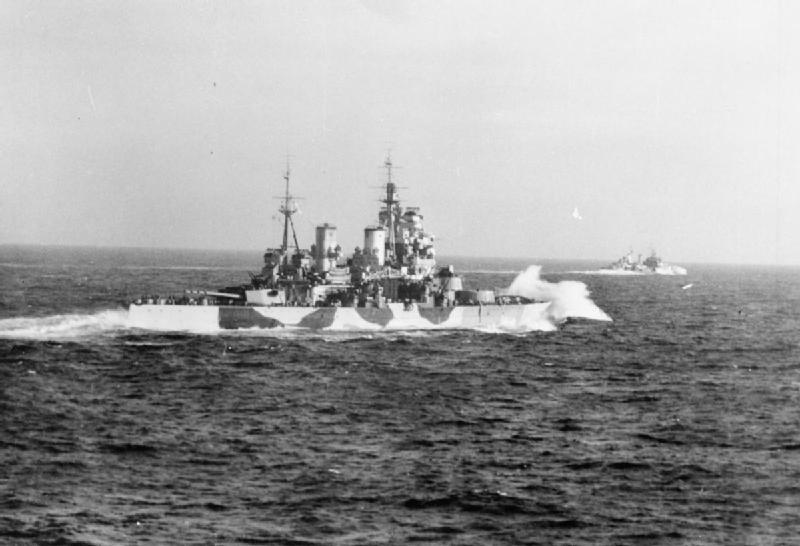
With HMS Belfast (background) during Operation Leader, 5-6 October 1943
By October 1943 she joined HMS Duke of York and the cruiser USS Tuscaloosa, as a cover for Operation Leader. This was an early attempt to destroy German presence in Norway and especially merchant traffic. They covered specifically USS Ranger which would provide the air strikes. This operation was merely a test as German forces here were taken completely by surprise since the area never has been raided in two years. If not crippling for the Germans (a few vessels were sunk), it revealed impreparedness and serious weaknesses in armed forces preparatiosn and composition, notably inadequate Luftwaffe response. Radio transmitters com were intercepted by agents of the “Pisces” group and of the “Crux” group.
By February 1944, she repeated the mission, this time in company of the French battleship Richelieu escorted by cruisers and destroyers. Again she covered air striked from HMS Furious carried out air strikes against German targets in Norway during Operation Bayleaf. This less known operation took place on 24 February 1944 as an anti-shipping sweep, repeat of Operation Posthorn.
It focused between Lepsøya and Edøya, from HMS Formidable escorted by Bermuda and Sheffield. The DDs Musketeer and Błyskawica were damaged in a collision when departing Scapa Flow, leading to its postponement. Furious was part of the covering force for JW.57 convoy, also launching her aircraft along the north coast of Norway.

Tirpitz from July 1943, when based in Altafjord
On 3 April, now as flagship, Vice Admiral Sir Henry Moore, HMS Howe again was part of the cover for Operation Tungsten, the first really successful air strike against KMS Tirpitz.
The Operatiopn went on on 1-3 April 1944, with as goal to damage or sink her while based in the Kaafjord spur, Altafjord (far north of Norway) following a period of repairs. The damage inflicted was not sufficient to sink or disable her but she still suffered considerable damage to her superstructure and unarmored areas, having 122 killed, 316 wounded. Repairs were only done by mid-July. More carrier raids would follow until August 1944 but none was successful and meanwhile, Howe was no longer part of the distant cover.
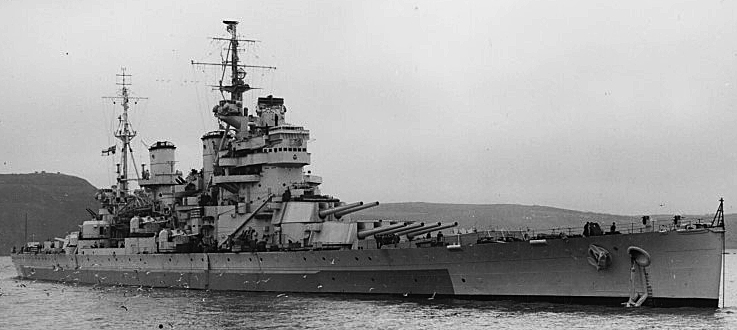
HMS Anson at Devonport, March 1945, after refit
Anson was sent to Scapa afterwards for rest and replenishement. Examined, it was decided to decommission her for a major refit in June 1944. She was not back with the fleet before March 1945, when the war was almpost over in Europe. Having no more to do there, it was decided to send her with HMS Duke of York to join the British Pacific Fleet and the rest of the KGV class to continue the war with the USN. But when she eventually arrived in July, the war was mostly over. She was diverted to Australia forst and was just leaving Sydney for Hong Kong with HMS Duke of York, and a RN-commonwealth task force when learning of the surrender, and she accepted the surrender of the Japanese forces in Hong Kong. Later she departed to be present on time in Tokyo Bay for the final, official Japanese surrender aboard USS Missouri.
After the war, HMS Anson stayed in the Pacific, becoming flagship of the 1st Battle Squadron, British Pacific Fleet. She supported the full liberarion of Hong Kong. She had a brief refit in Sydney and sailed to Hobart in February 1946 to have to honor of carrying the Duke (Governor-General of Australia) and Duchess of Gloucester back to Sydney. At last she departed for home, arriving back on 29 July 1946. She had a short refit and went on with peacetime duties until November 1949. The admirakty decided to have her in prolongated reserve, preserved, towed in 1951 to Gare Loch. On 17 December 1957 like the others, she was sold for scrapped, to Shipbreaking Industries, Faslane and BU in 1958.


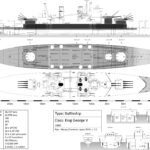

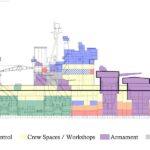
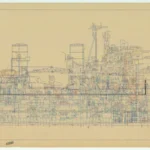
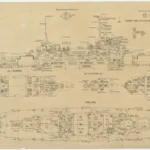
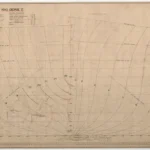
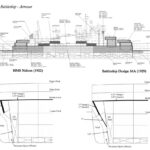


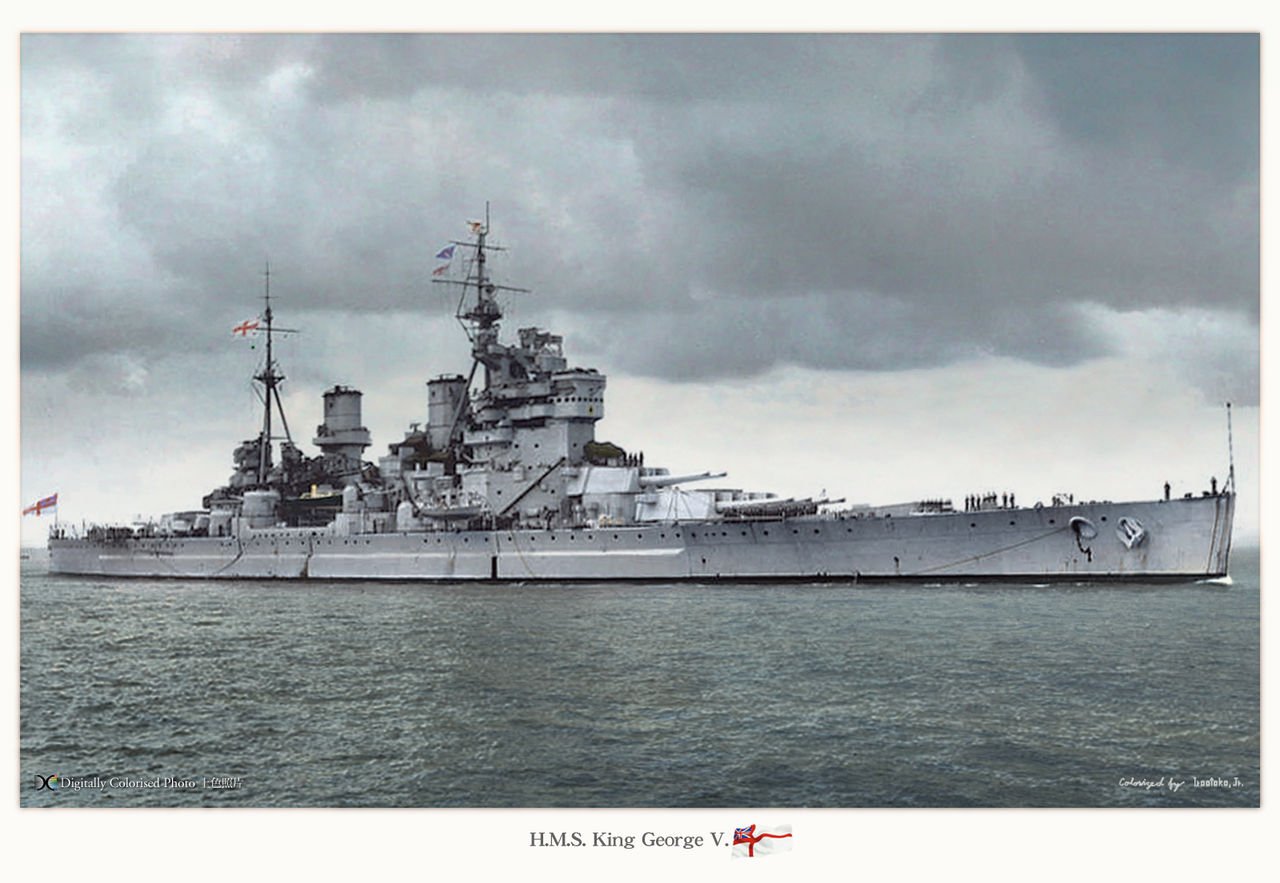
 Latest Facebook Entry -
Latest Facebook Entry -  X(Tweeter) Naval Encyclopedia's deck archive
X(Tweeter) Naval Encyclopedia's deck archive Instagram (@navalencyc)
Instagram (@navalencyc)





 French Navy
French Navy Royal Navy
Royal Navy Russian Navy
Russian Navy Armada Espanola
Armada Espanola Austrian Navy
Austrian Navy K.u.K. Kriegsmarine
K.u.K. Kriegsmarine Dansk Marine
Dansk Marine Nautiko Hellenon
Nautiko Hellenon Koninklije Marine 1870
Koninklije Marine 1870 Marinha do Brasil
Marinha do Brasil Osmanlı Donanması
Osmanlı Donanması Marina Do Peru
Marina Do Peru Marinha do Portugal
Marinha do Portugal Regia Marina 1870
Regia Marina 1870 Nihhon Kaigun 1870
Nihhon Kaigun 1870 Preußische Marine 1870
Preußische Marine 1870 Russkiy Flot 1870
Russkiy Flot 1870 Svenska marinen
Svenska marinen Søværnet
Søværnet Union Navy
Union Navy Confederate Navy
Confederate Navy Armada de Argentina
Armada de Argentina Imperial Chinese Navy
Imperial Chinese Navy Marinha do Portugal
Marinha do Portugal Mexico
Mexico Kaiserliche Marine
Kaiserliche Marine 1898 US Navy
1898 US Navy Sovietskiy Flot
Sovietskiy Flot Royal Canadian Navy
Royal Canadian Navy Royal Australian Navy
Royal Australian Navy RNZN Fleet
RNZN Fleet Chinese Navy 1937
Chinese Navy 1937 Kriegsmarine
Kriegsmarine Chilean Navy
Chilean Navy Danish Navy
Danish Navy Finnish Navy
Finnish Navy Hellenic Navy
Hellenic Navy Polish Navy
Polish Navy Romanian Navy
Romanian Navy Turkish Navy
Turkish Navy Royal Yugoslav Navy
Royal Yugoslav Navy Royal Thai Navy
Royal Thai Navy Minor Navies
Minor Navies Albania
Albania Austria
Austria Belgium
Belgium Columbia
Columbia Costa Rica
Costa Rica Cuba
Cuba Czechoslovakia
Czechoslovakia Dominican Republic
Dominican Republic Haiti
Haiti Hungary
Hungary Honduras
Honduras Estonia
Estonia Iceland
Iceland Eire
Eire Equador
Equador Iran
Iran Iraq
Iraq Latvia
Latvia Liberia
Liberia Lithuania
Lithuania Mandchukuo
Mandchukuo Morocco
Morocco Nicaragua
Nicaragua Persia
Persia San Salvador
San Salvador Sarawak
Sarawak Uruguay
Uruguay Venezuela
Venezuela Zanzibar
Zanzibar Warsaw Pact Navies
Warsaw Pact Navies Bulgaria
Bulgaria Hungary
Hungary

 Bundesmarine
Bundesmarine Dutch Navy
Dutch Navy Hellenic Navy
Hellenic Navy Marina Militare
Marina Militare Yugoslav Navy
Yugoslav Navy Chinese Navy
Chinese Navy Indian Navy
Indian Navy Indonesian Navy
Indonesian Navy JMSDF
JMSDF North Korean Navy
North Korean Navy Pakistani Navy
Pakistani Navy Philippines Navy
Philippines Navy ROKN
ROKN Rep. of Singapore Navy
Rep. of Singapore Navy Taiwanese Navy
Taiwanese Navy IDF Navy
IDF Navy Saudi Navy
Saudi Navy Royal New Zealand Navy
Royal New Zealand Navy Egyptian Navy
Egyptian Navy South African Navy
South African Navy






























 Ukrainian Navy
Ukrainian Navy dbodesign
dbodesign
According to Nav Weaps this statement is definitely wrong and I have to also doubt the vertical penetration as well. The American Mark 8 AP shell weighed 2700 pounds. The 14 inc British Mk 7 AP shell 1590 pounds. According to the gunnery tables at Nav Weaps Mk 8 side armor penetration at 15,000 yards was 20.47 inches and at 20,000 yards 17.62 inches. The British Mk 7 side armor penetration 13.2 inches and 20,000 yards 11.2 inches. Vertical penetration superiority was similar as well. The Mik 8 in fact was in a class of it’s own. It weighed 1200 pounds more and its striking velocity was greater.
http://www.navweaps.com/Weapons/WNBR_14-45_mk7.php
http://www.navweaps.com/Weapons/WNUS_16-45_mk6.php
Hi Rob
Unless the numbers i reported are misplaced, My source is Matt Warwidk which worked with the original logs and stats. Sometimes naweaps can be off… as trustful and reliable this source could be.